In mid-1972, preparations were underway for the final Apollo Moon landing mission, planned for launch in December 1972. Apollo 17 astronauts Commander Eugene A. “Gene” Cernan, Command Module Pilot Ronald E. Evans, and Lunar Module Pilot Harrison H. “Jack” Schmitt, a geologist, completed several geology field trips and practiced portions of their 12-day mission to explore the Taurus-Littrow region of the Moon. Ground crews at NASA’s Kennedy Space Center (KSC) in Florida prepared the Apollo spacecraft and the Saturn V rocket, and the astronauts tested the spacecraft in altitude chambers. Once they assembled the rocket and spacecraft, workers rolled the vehicle to the launch pad. While preparing for the final Apollo Moon landing, workers across NASA were also getting ready for Skylab, America’s first space station, scheduled for launch in 1973.
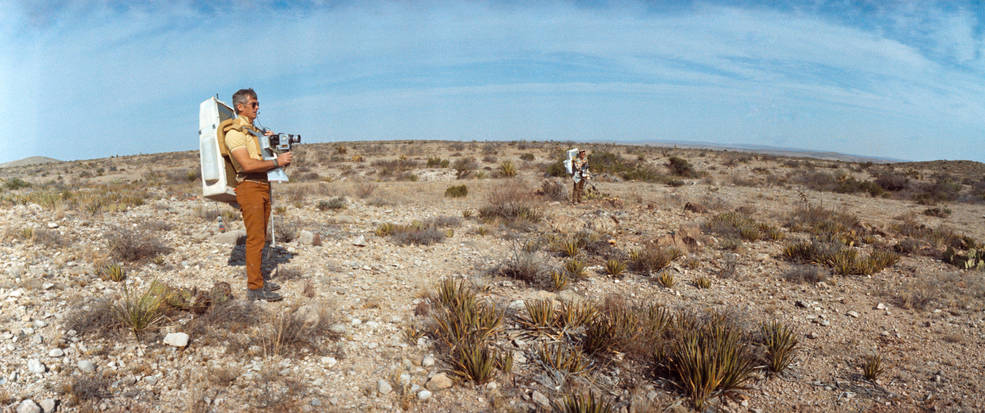
Panoramic view of Apollo 17 astronauts Eugene A. Cernan, left, and Harrison
H. “Jack” Schmitt during geology training in Sudbury, Ontario.
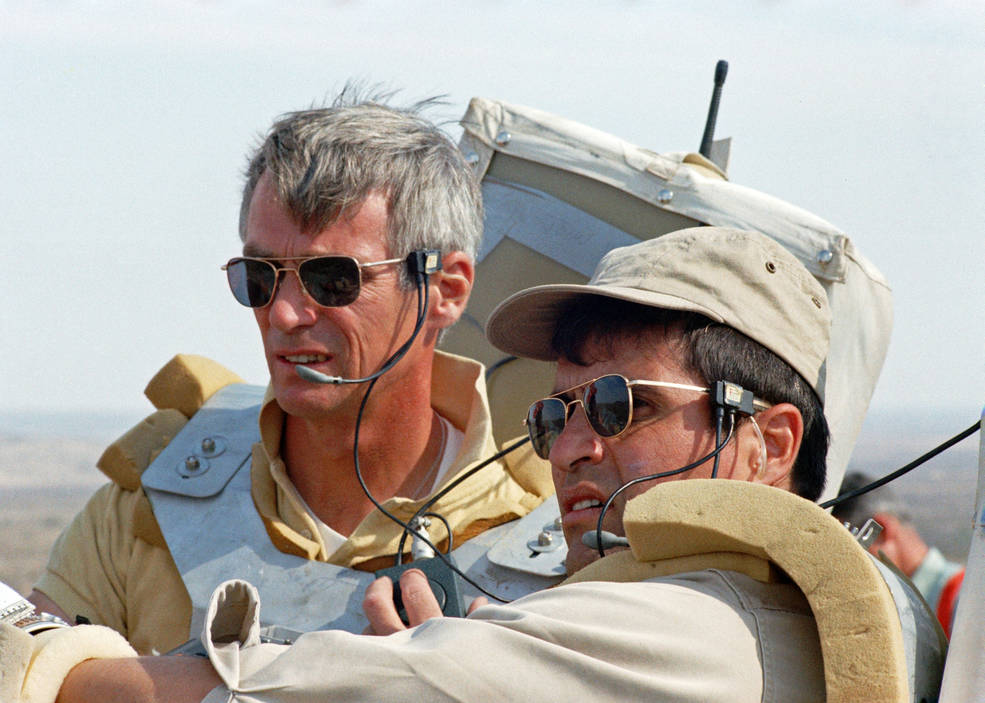
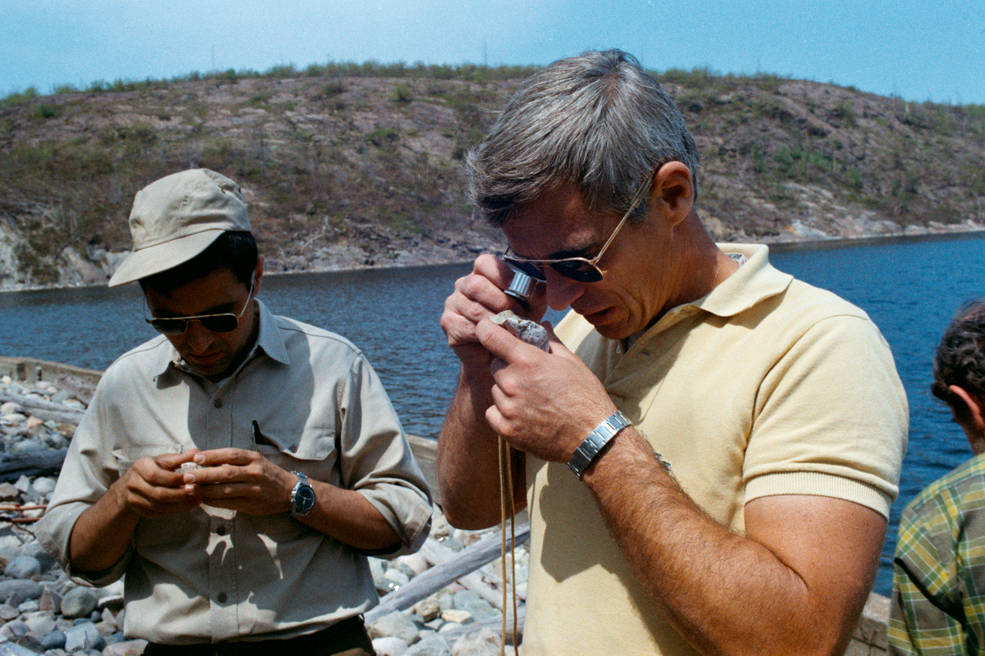
Left: Apollo 17 astronauts Eugene A. Cernan, left, and Harrison H. “Jack”
Schmitt during geology training in Sudbury, Ontario. Right: Schmitt, left,
and Cernan examine rock samples in Sudbury.
As with Apollo 15 and 16, Apollo 17’s mission focused primarily on lunar geology. In addition to receiving many hours of classroom lectures on the subject, the Apollo 17 astronauts participated in several geology field trips to sites similar to the terrain expected at the Taurus-Littrow landing site on the Moon. In May, the astronauts, accompanied by a team of geologists, traveled to Sudbury, Ontario, Canada, the site of a meteorite impact. Following an aerial survey of the area, Cernan and Schmitt spent two days inspecting the local geology. Apollo 17 Flight Director M.P. “Pete” Frank and several NASA public affairs officials attended the field trip. In June, the crew spent a week in Hawaii, using the Grover, a terrestrial version of the Lunar Roving Vehicle (LRV) designed by the U.S. Geologic Service, on several traverses across the lava flows of the Kilauea and Mauna Kea volcanos. In July, they spent two days exploring igneous formations in Stillwater, Montana, and in August another two days exploring artificial craters created by underground nuclear explosions at the Nevada Test Site near Tonopah.
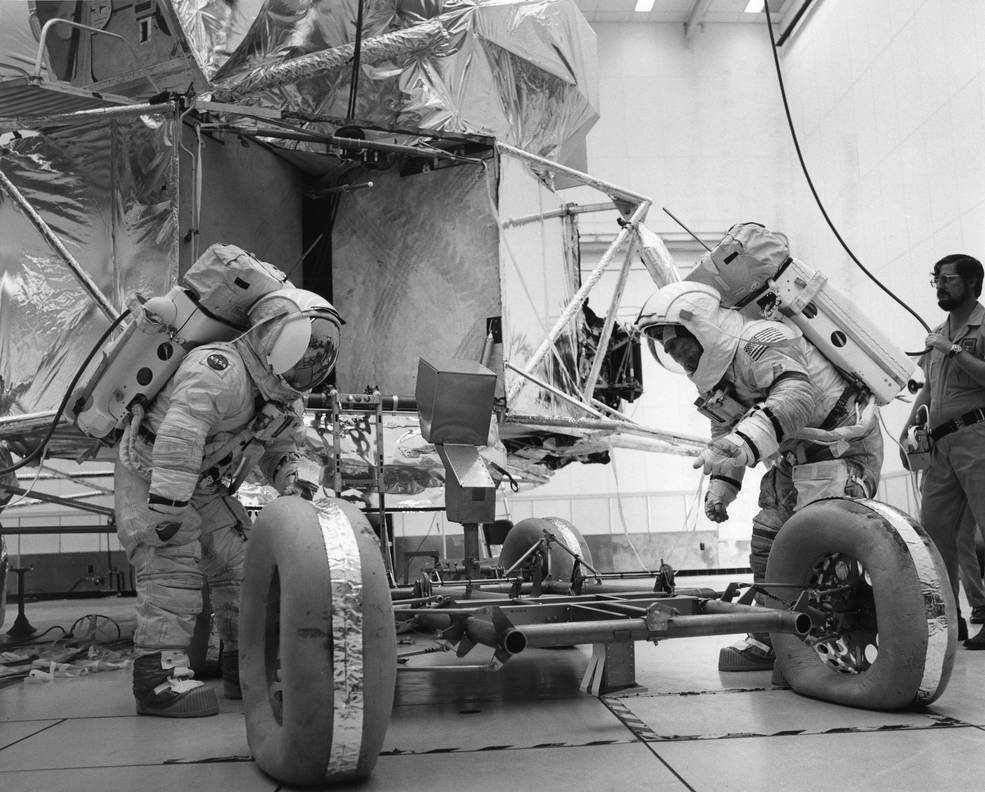
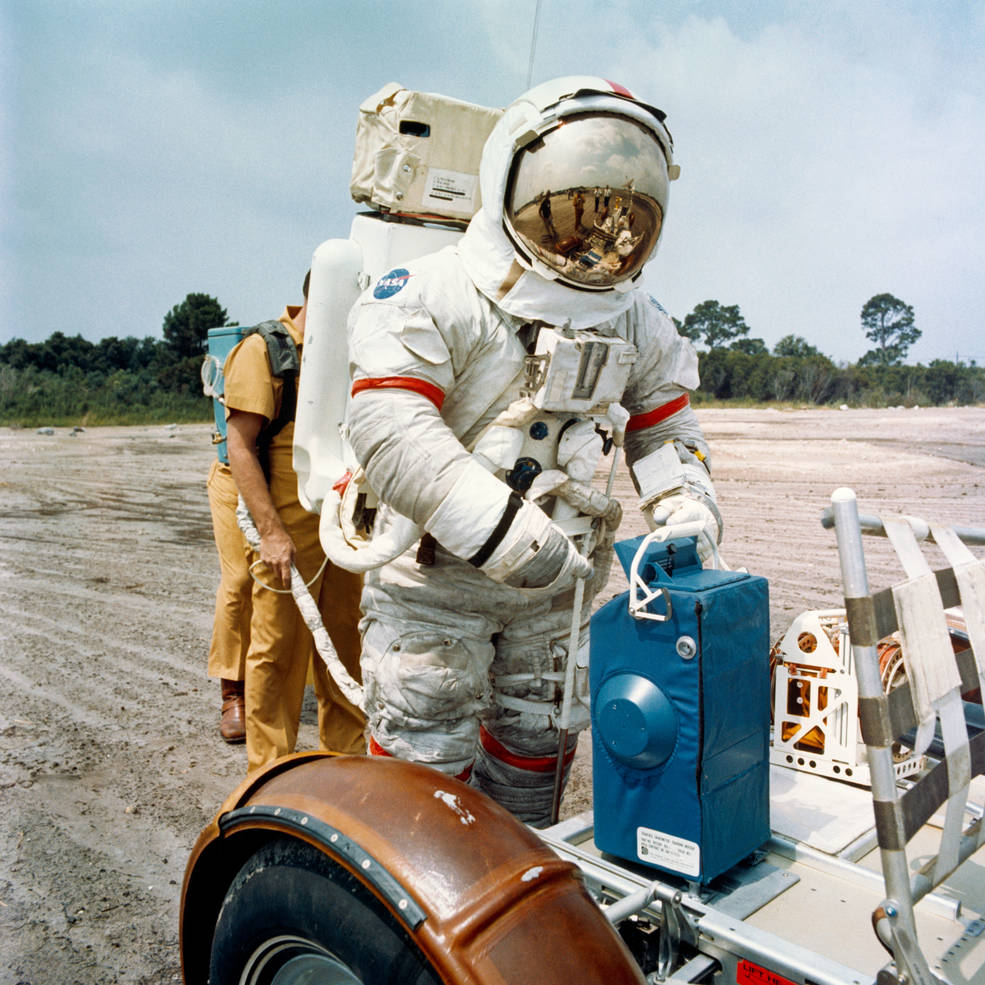
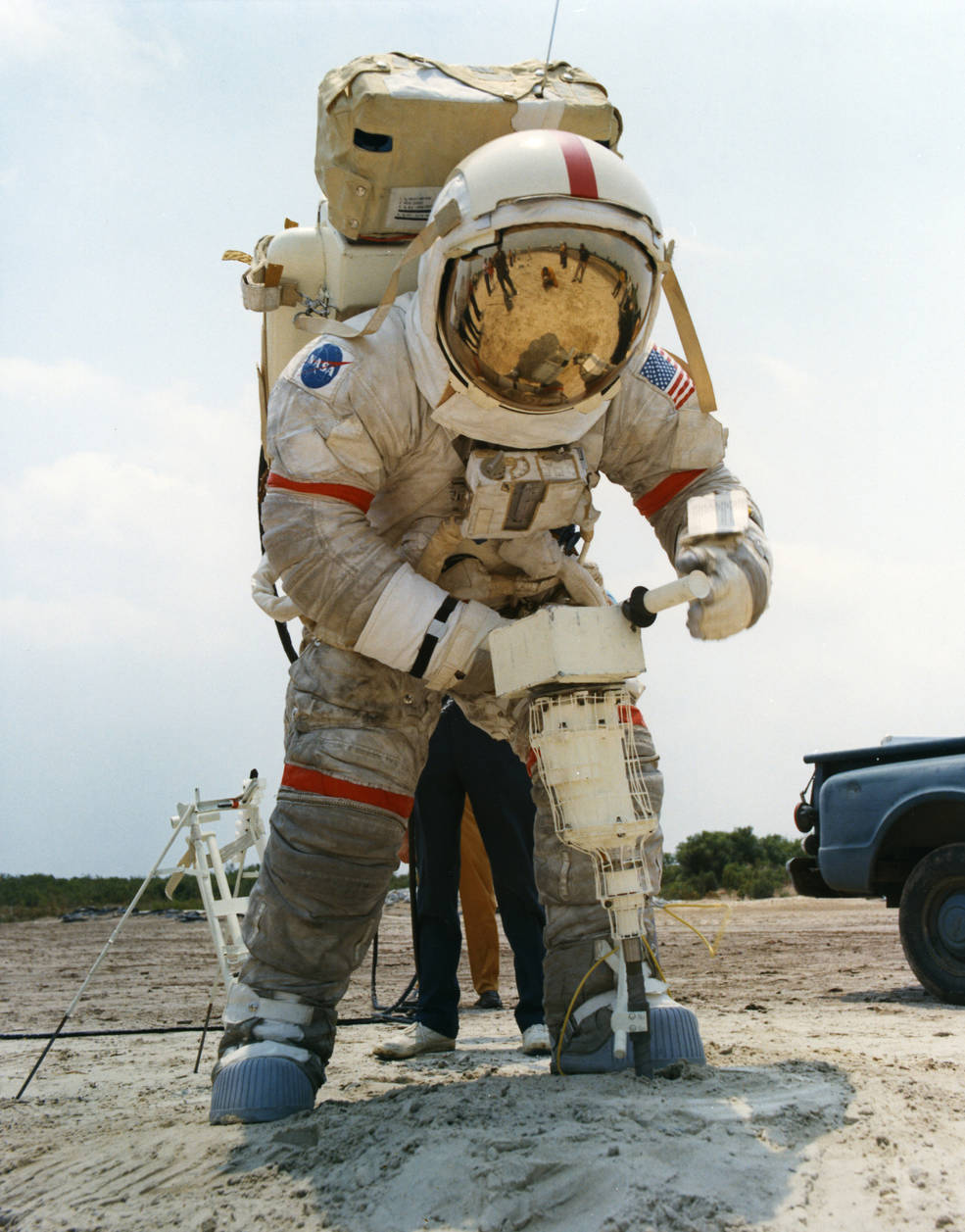
Left: At NASA’s Kennedy Space Center (KSC) in Florida, Apollo 17 astronauts Harrison H.
“Jack” Schmitt, left, and Eugene A. Cernan practice deploying a training version of the
Lunar Roving Vehicle (LRV). Middle: Cernan practices deploying science instruments
from the LRV at KSC’s rockpile. Right: Cernan practices using the lunar
drill at the rockpile.
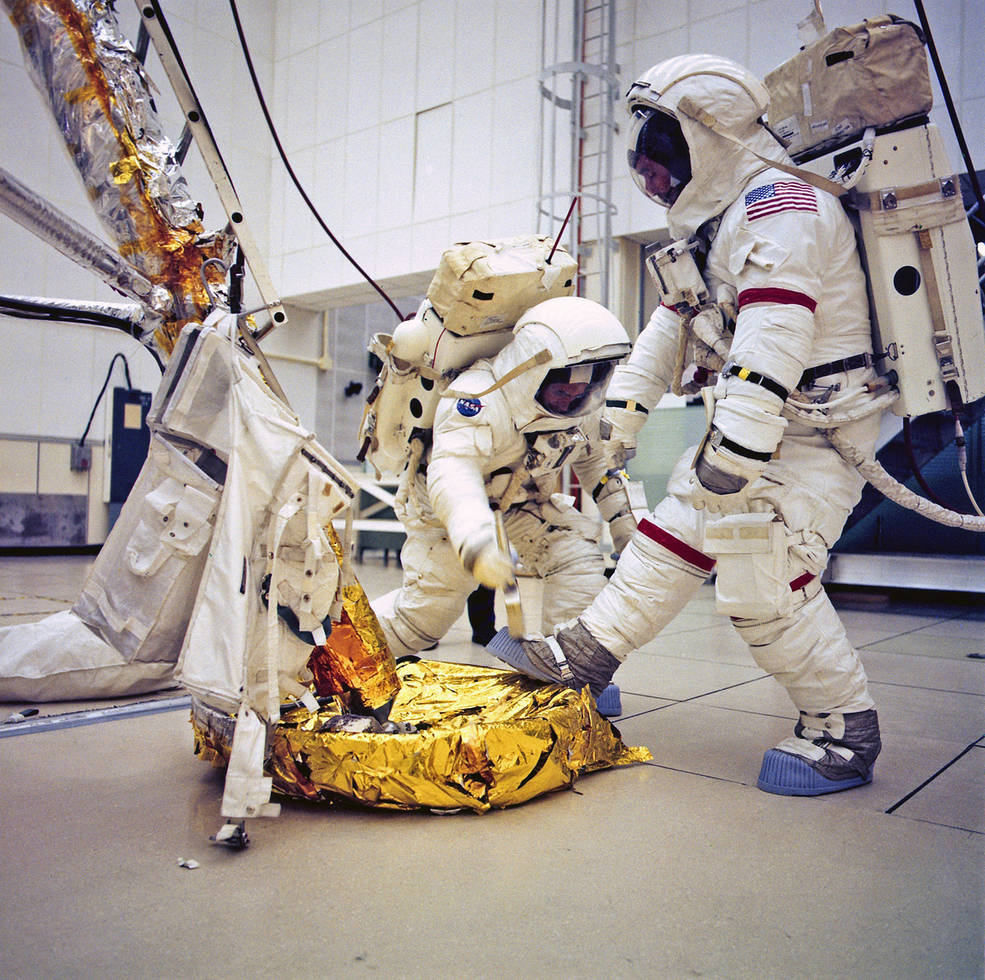
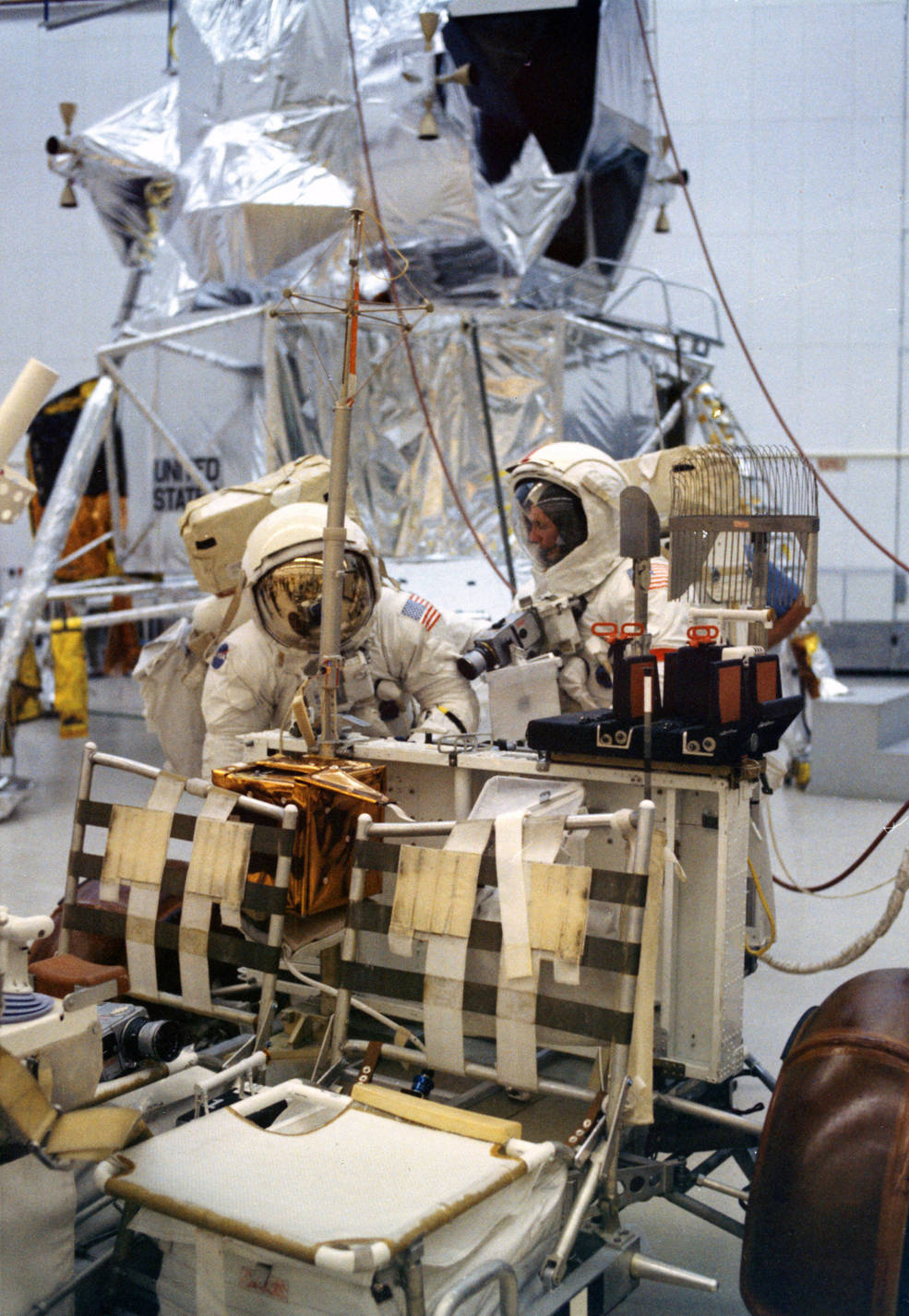
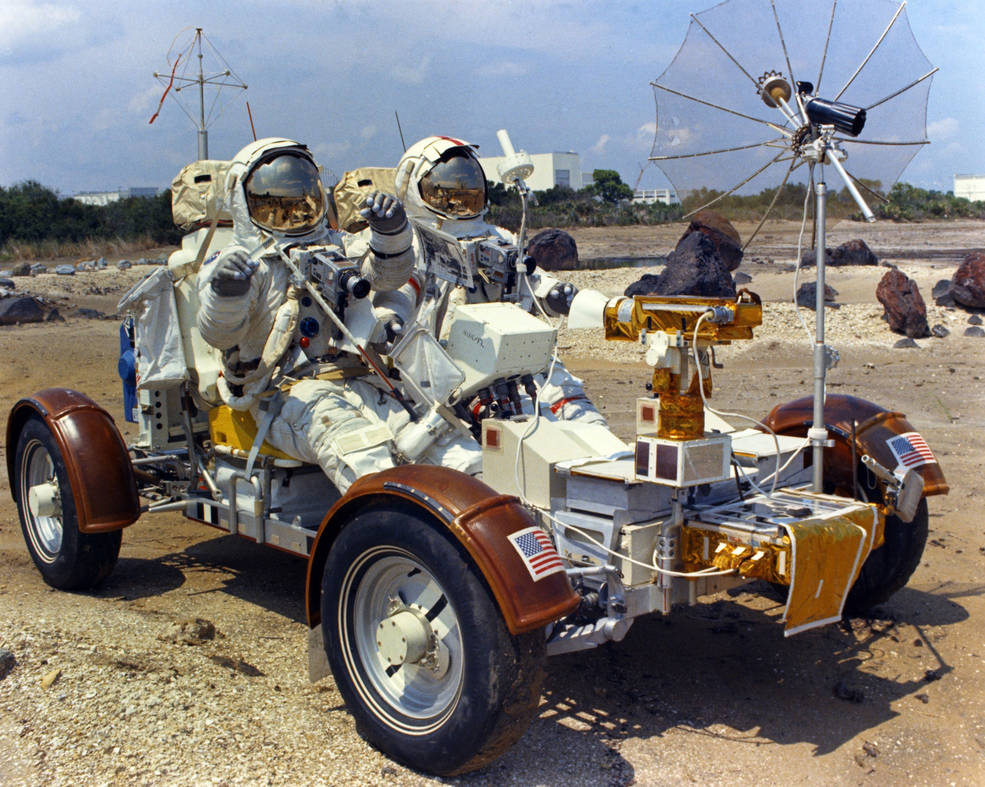
Left: At NASA’s Kennedy Space Center (KSC) in Florida, Apollo 17 astronaut Harrison H.
“Jack” Schmitt, left, practices brushing lunar dust from fellow astronaut Eugene A.
Cernan’s boot. Middle: Schmitt, left, and Cernan practice loading gear onto the
Lunar Roving Vehicle (LRV). Right: Schmitt, left, and Cernan drives the LRV
during training at KSC’s rockpile.
In addition to the geology training, the Apollo 17 astronauts practiced their three lunar surface traverses and the spacewalk to retrieve film cassettes from the Service Module’s Scientific Instrument Module bay, part of the lunar orbital science. At KSC, Cernan and Schmitt practiced deploying the LRV from the Lunar Module (LM) and driving it around the rockpile, an outdoor area set up to simulate the lunar surface. As on Apollo 15 and 16, the LRV allowed the astronauts to venture farther to accomplish their geology excursions. They also practiced setting up the instruments of the Apollo Lunar Science Experiment Package. Evans trained for his spacewalk in the Water Immersion Facility at the Manned Spacecraft Center (MSC), now NASA’s Johnson Space Center in Houston. Cernan practiced flying the final several hundred feet of the descent to the lunar surface using the Lunar Landing Training Vehicle at Ellington Air Force Base near MSC.
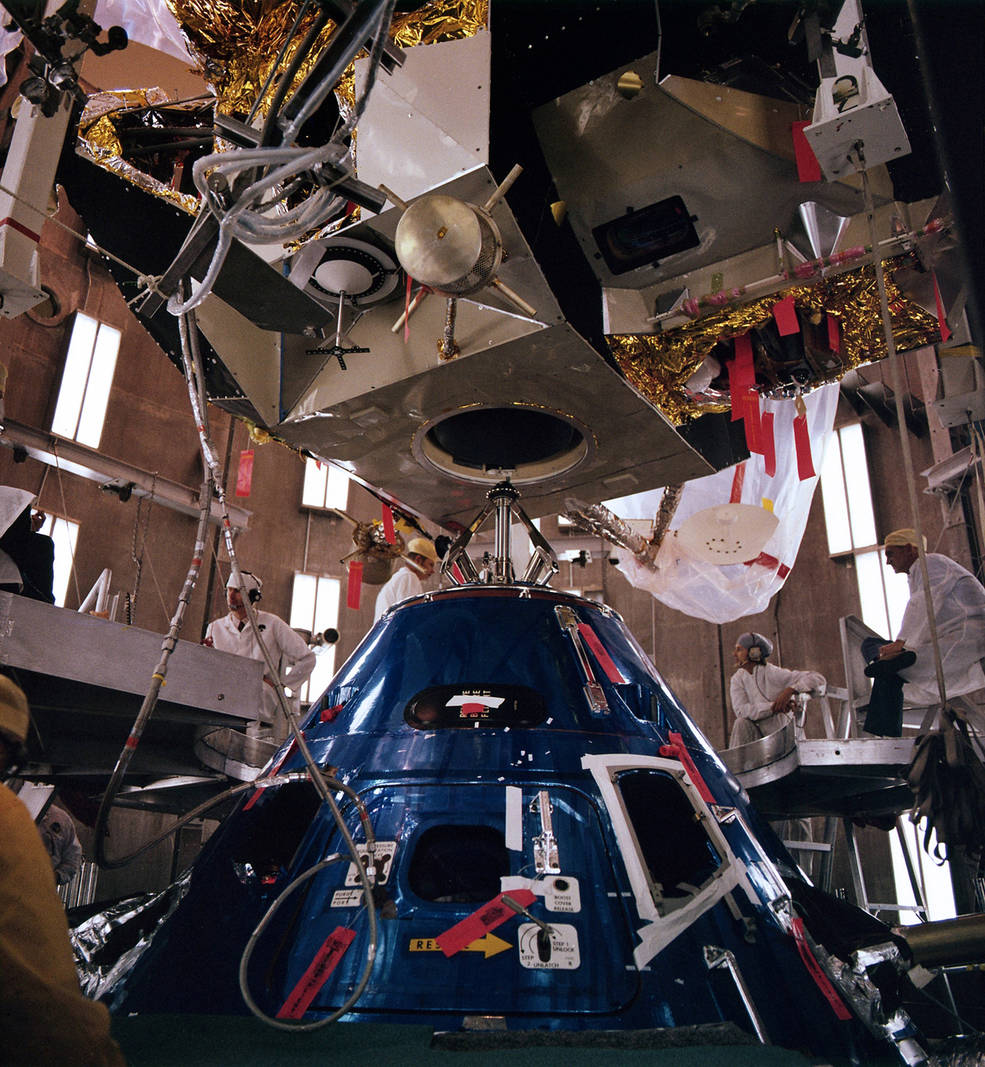
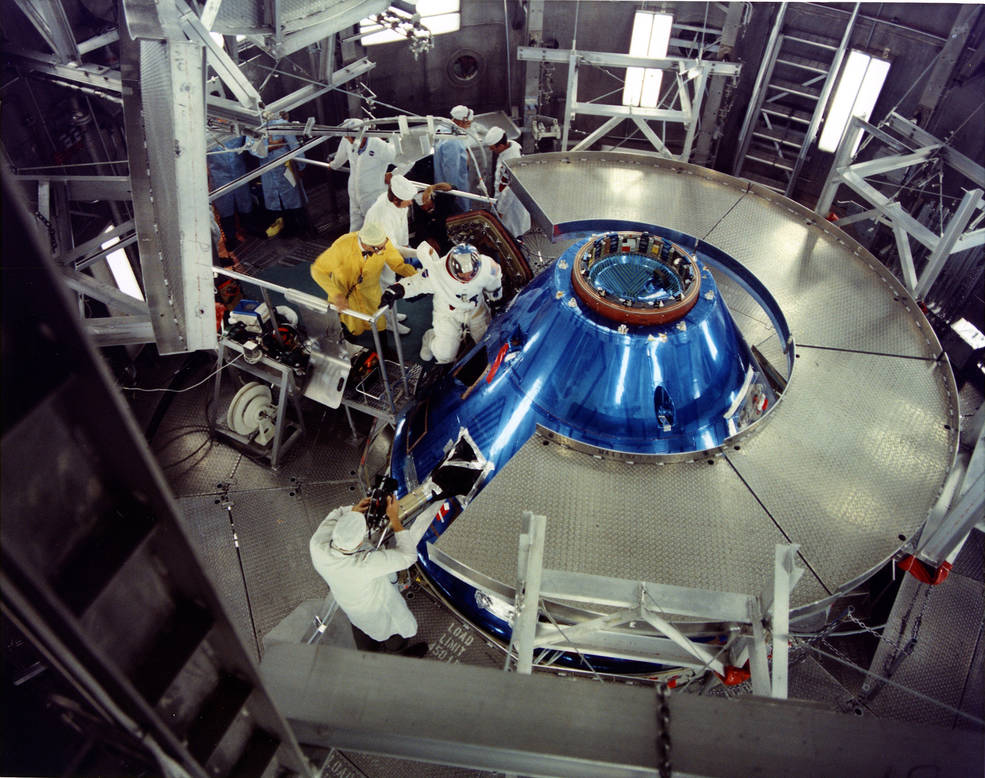
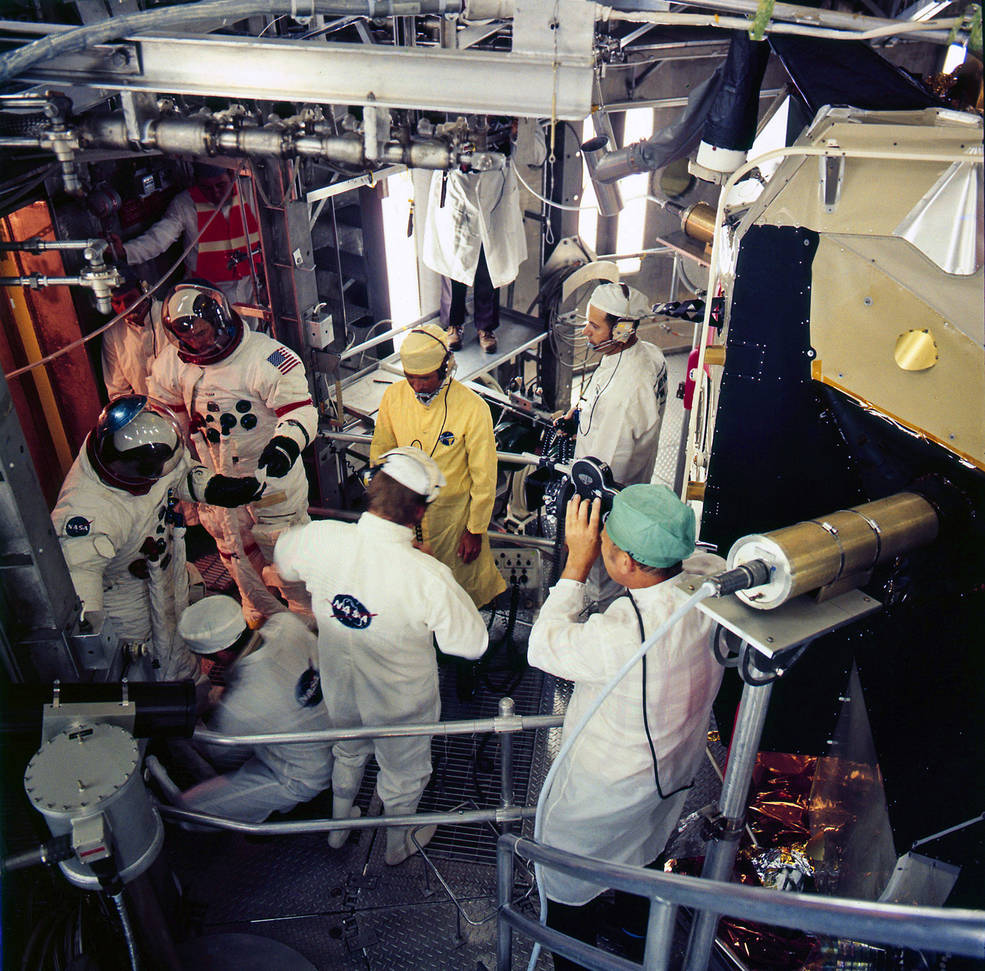
Left: Engineers conduct a docking test of the Apollo 17 Command Module (CM) and Lunar Module (LM) at NASA’s Kennedy Space Center in Florida. Middle: Apollo astronauts Eugene A. Cernan, Ronald C. Evans, and Harrison H. “Jack” Schmitt prepare to conduct an altitude test of the CM. Right: Schmitt, left, and Cernan prepare for an altitude test of the LM.
In KSC’s Manned Spacecraft Operations Building (MSOB), engineers prepared the components of the Apollo 17 spacecraft. The LM for the mission had arrived at KSC in June 1971 and remained in storage until preflight processing began. The Command Module (CM) and SM arrived on March 14, 1972, and workers mated them in an altitude chamber two days later. They conducted a docking test by lowering the LM’s ascent stage onto the CM on May 2. The next time the two spacecraft docked, they were on their way to the Moon. They joined the LM’s two stages on May 18 in preparation for altitude chamber tests. In June, Cernan, Evans, and Schmitt, and the original Apollo 17 backup crew of David R. Scott, Alfred M. Worden and James B. Irwin, completed altitude tests of the CM. On July 1, NASA managers replaced the backup crew with John W. Young, Stuart A. Roosa, and Charles M. Duke, and the new backups joined the prime crew to complete altitude tests of the LM in July.
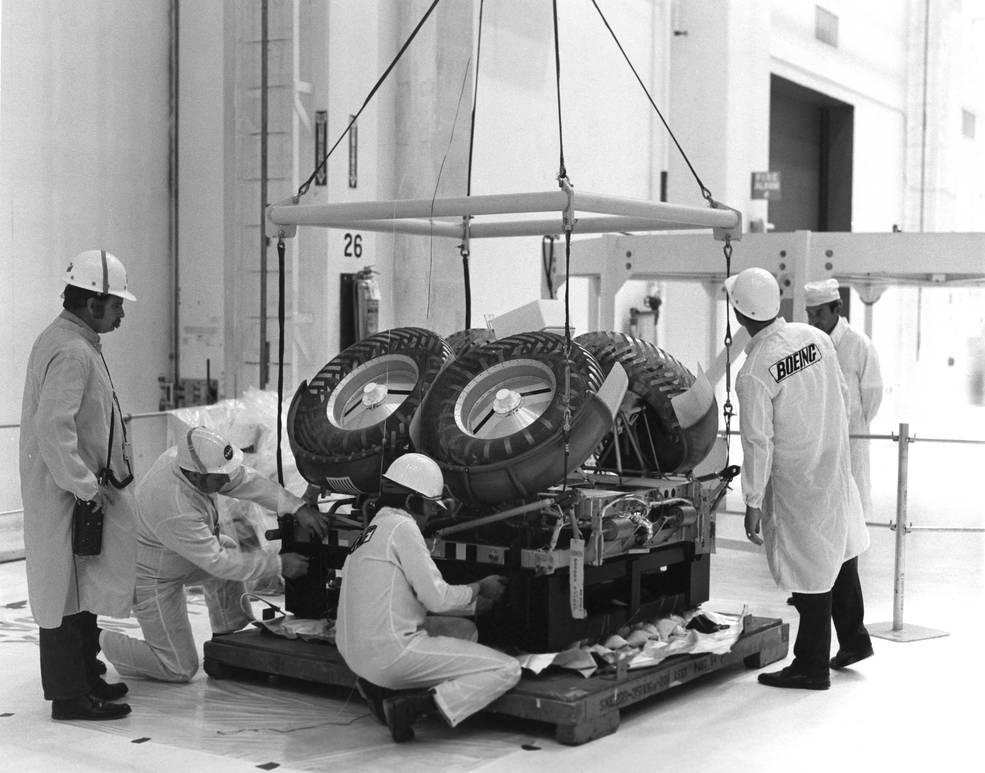
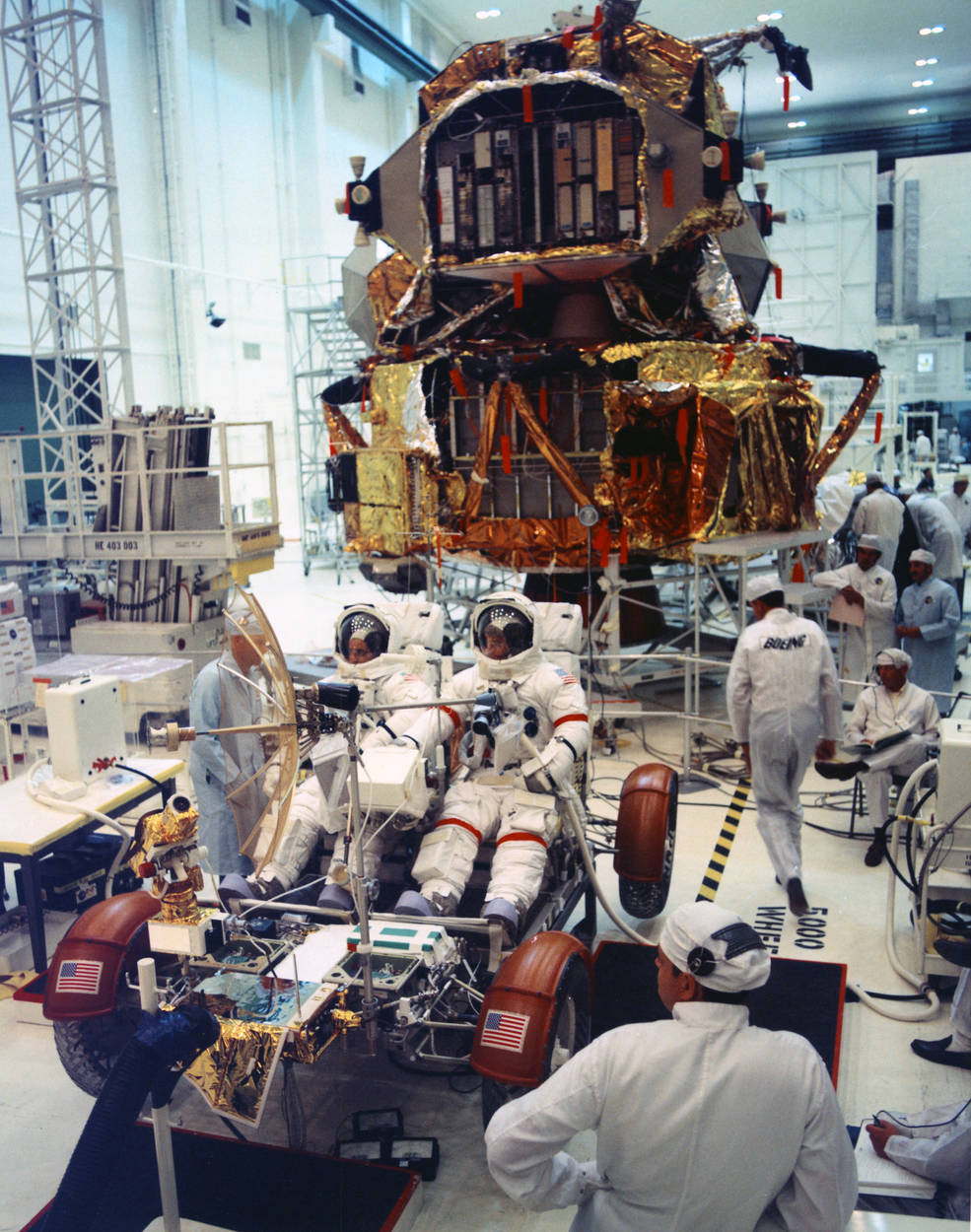
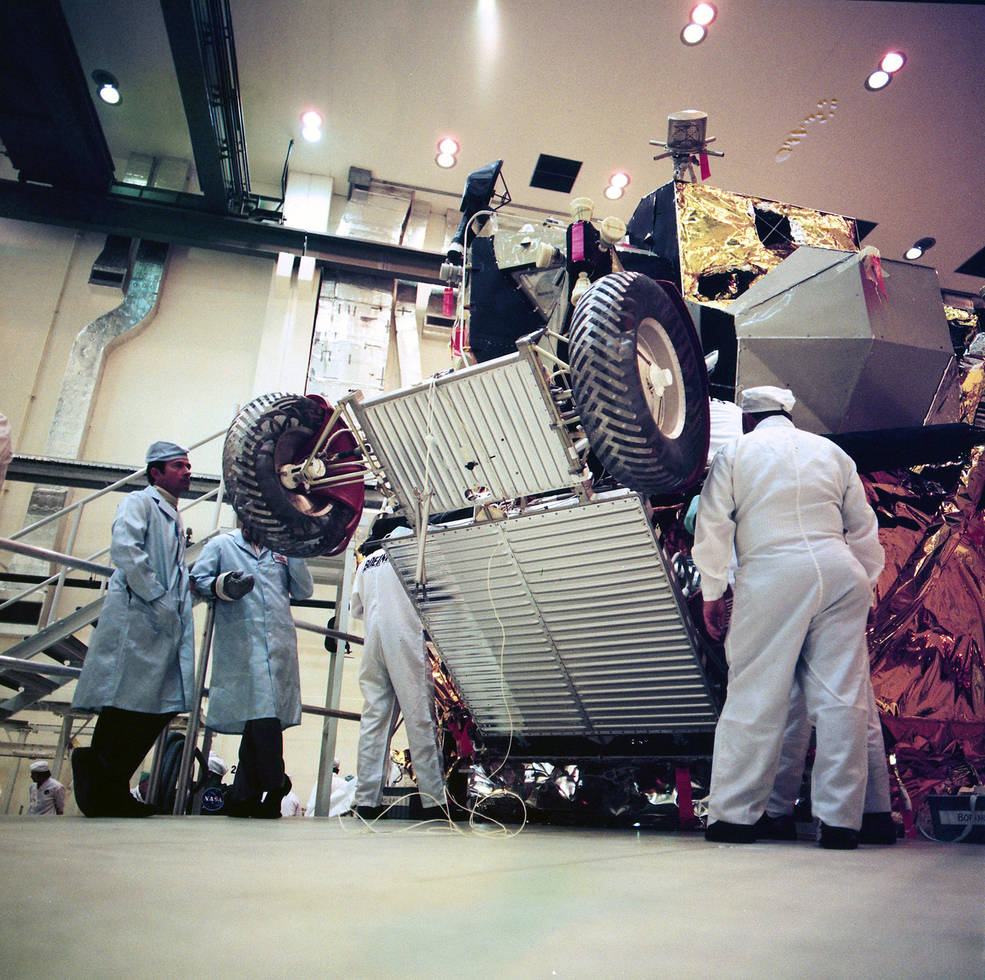
Left: Workers uncrate the Apollo 17 Lunar Roving Vehicle (LRV) following its arrival
at NASA’s Kennedy Space Center. Middle: Apollo 17 astronauts Harrison H. “Jack”
Schmitt, left, and Eugene A. Cernan conduct a test of the LRV. Right: Ground
crews rehearse deploying the LRV from the Lunar Module.
The LRV for Apollo 17 arrived at KSC on June 2, and workers in the MSOB unpacked it to begin testing. Cernan and Schmitt, and their backups Young and Duke, performed fit checks with LRV while clad in their spacesuits. They conducted a final deployment training session before ground crews folded up the LRV one last time and installed it on the LM on Aug. 13. The next deployment occurred on the lunar surface.
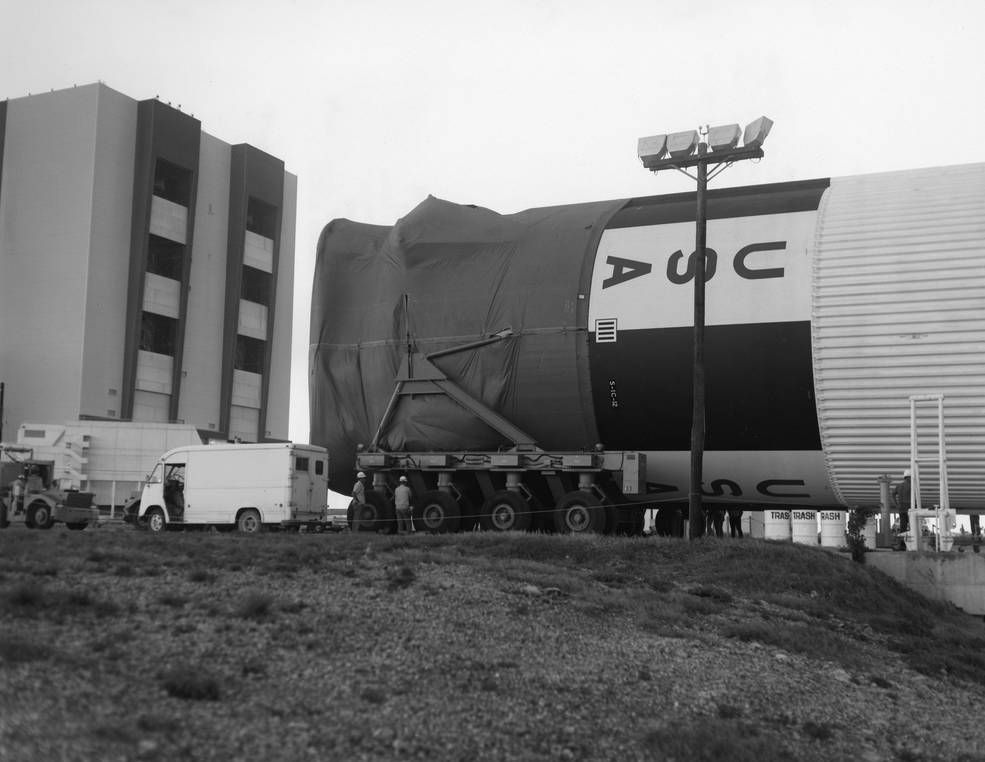
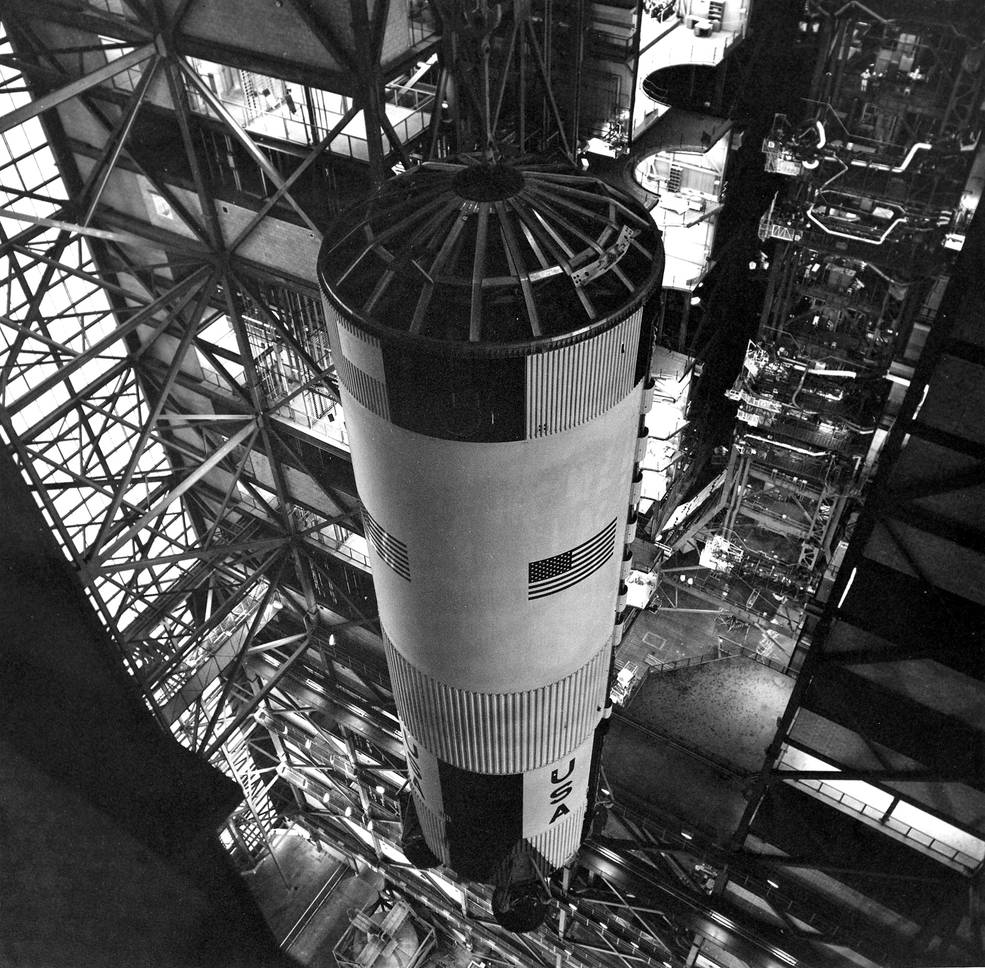
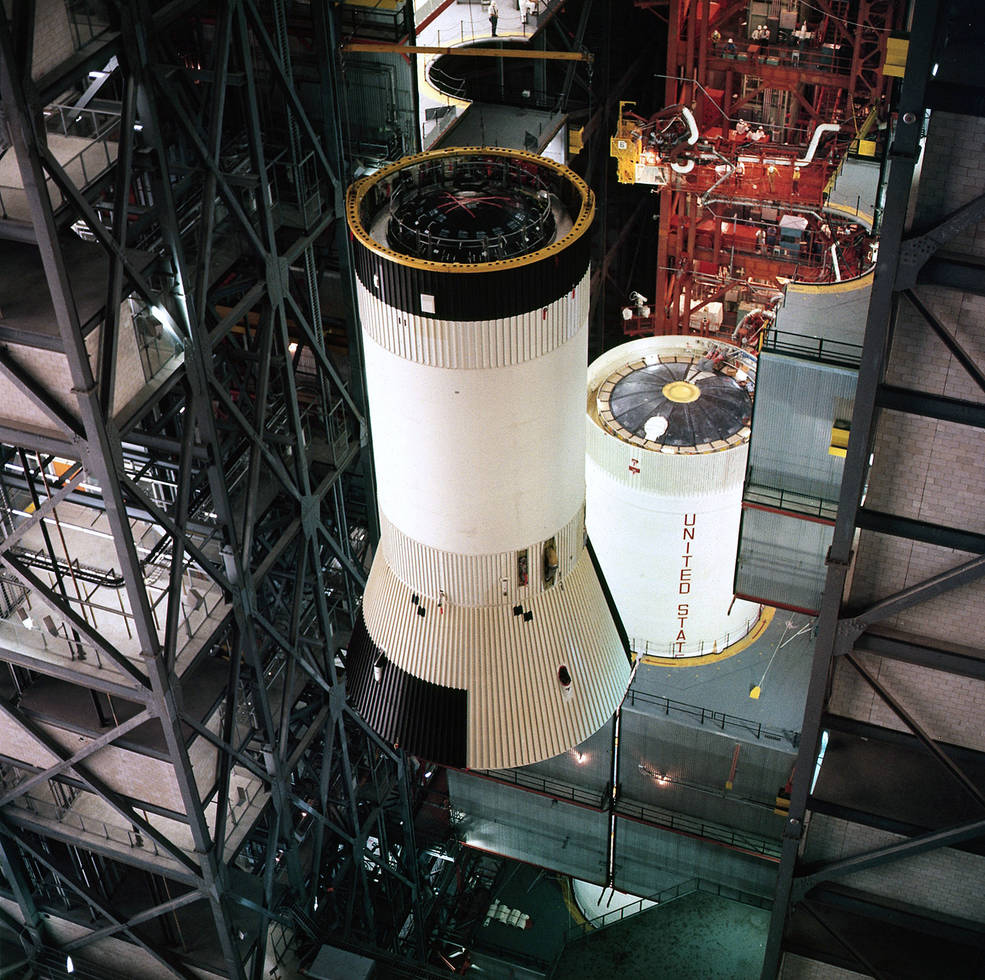
Left: The first stage of Apollo 17’s Saturn V rocket arrives at the Vehicle Assembly
Building (VAB) at NASA’s Kennedy Space Center in Florida. Middle: Workers hoist
the Saturn V’s first stage to place it onto a Mobile Launcher in the VAB.
Right: Workers prepare to stack the Saturn V’s third stage
onto the second stage.
In KSC’s cavernous Vehicle Assembly Building (VAB), workers began stacking the Apollo 17 Saturn V rocket. The second and third stages had arrived at KSC in October and December 1970, respectively, and remained in storage until the assembly process began. The first stage arrived by barge on May 11, 1972, and workers placed it on Mobile Launcher-3 (ML-3) in the VAB’s High Bay 3. They added the second stage on May 18, followed by the third stage on June 23.
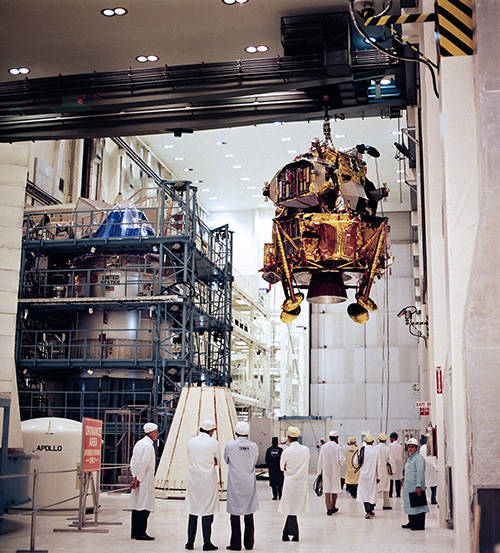
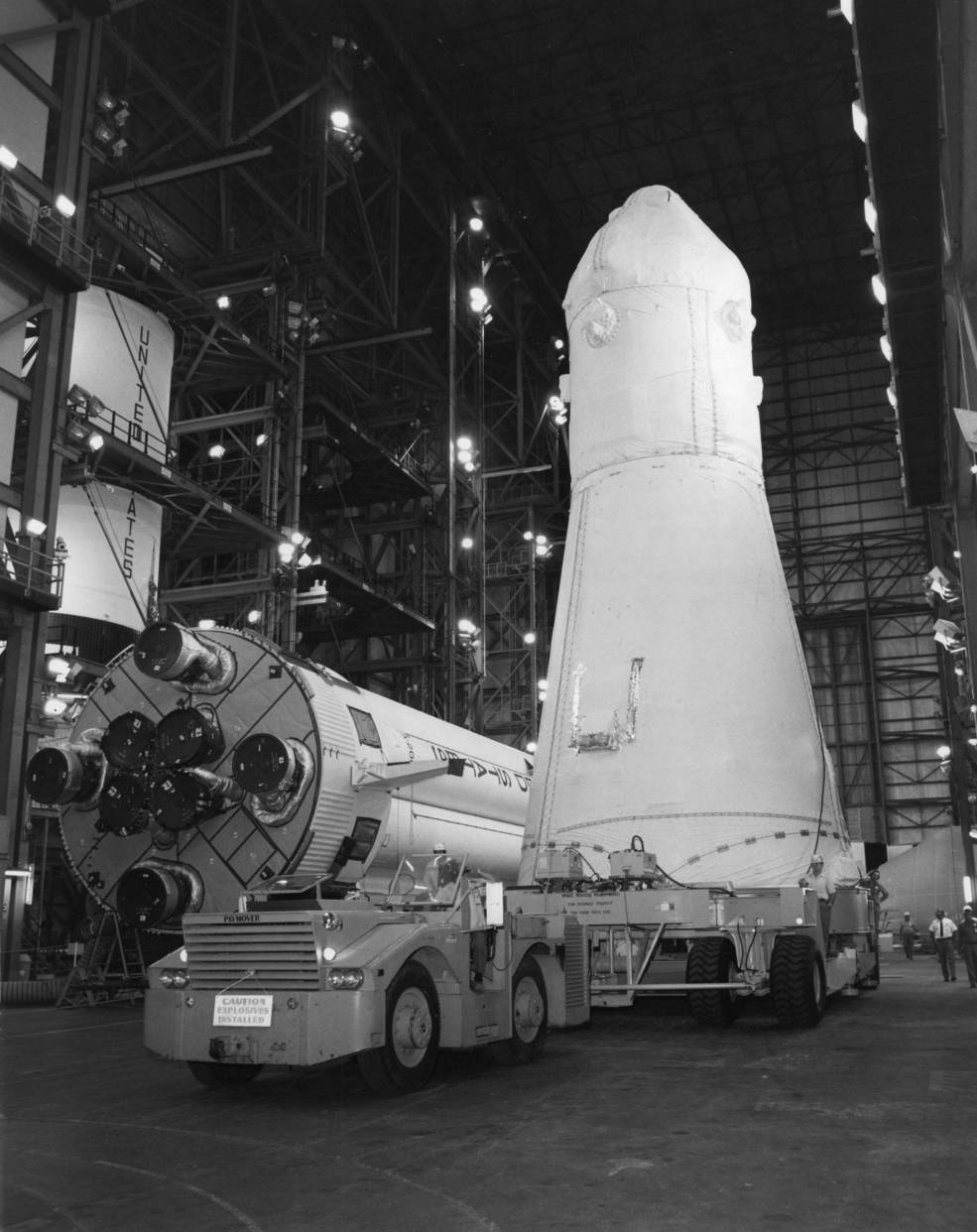
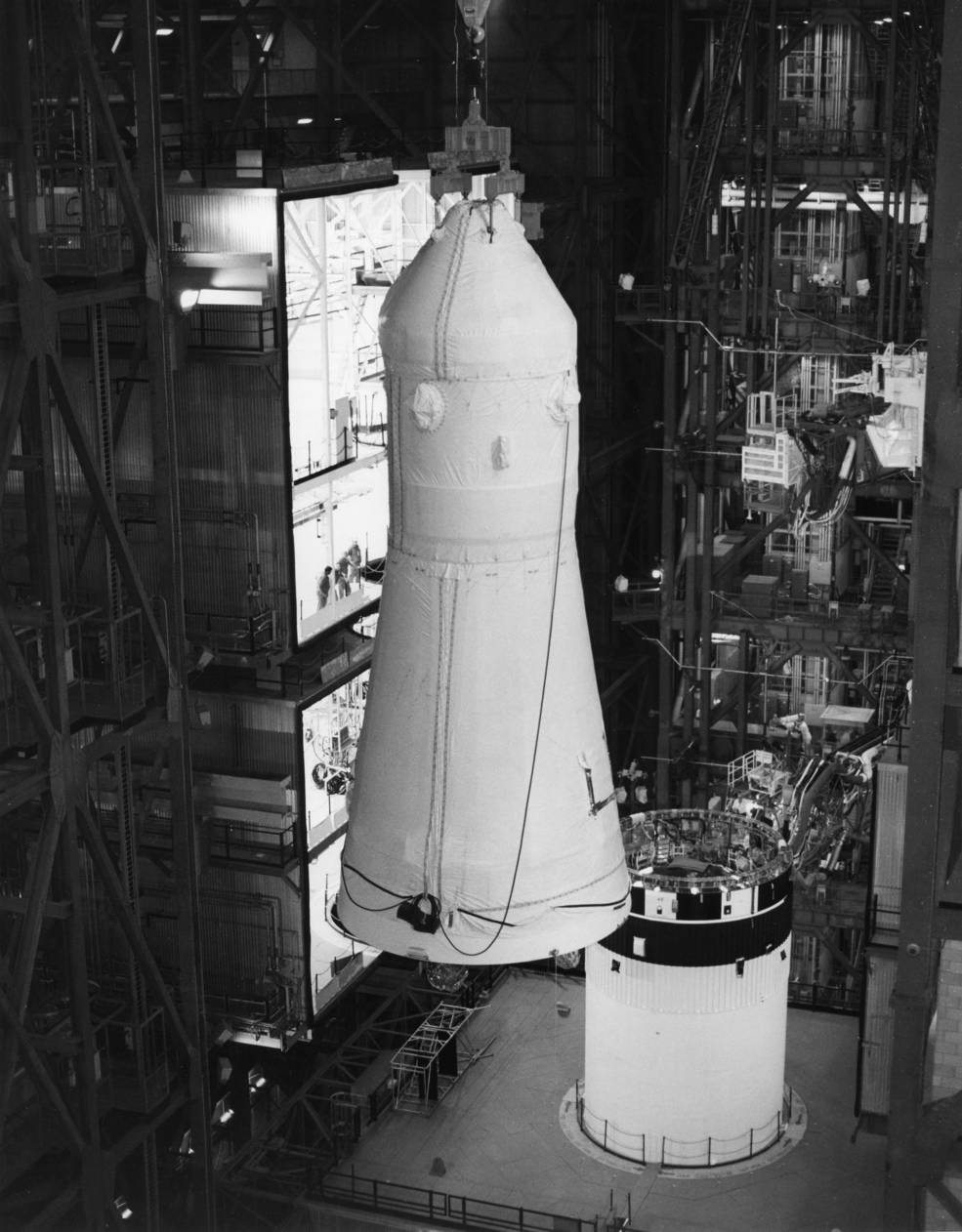
Left: At NASA’s Kennedy Space Center (KSC) in Florida, workers lift the Apollo 17
Lunar Module (LM) past the Command and Service Module (CSM) in preparation
for installation into the Spacecraft LM Adapter (SLA). Middle: In KSC’s
Vehicle Assembly Building (VAB), workers truck the assembled Apollo 17
spacecraft (CSM, LM, and SLA) past the first stage of the Saturn IB
rocket planned to launch the first crew to the Skylab space station
in 1973, and the second stage of the Saturn V to launch the space
station itself. Right: Workers lift the Apollo 17 spacecraft to
place it atop the third stage of the Saturn V rocket.
Following completion of the altitude chamber tests and installation of the LRV, workers in the MSOB first mated the LM to the lower portion of the Spacecraft LM Adapter (SLA) on Aug. 17 and added the four panels to enclose the lunar lander. Three days later, they installed the CSM atop the SLA. On Aug. 22, workers trucked the assembled spacecraft to the VAB, where ground crews placed it atop the stacked Saturn V rocket on Aug. 23. After the addition of the Launch Escape System tower, the vehicle was ready for its rollout to the launch pad.
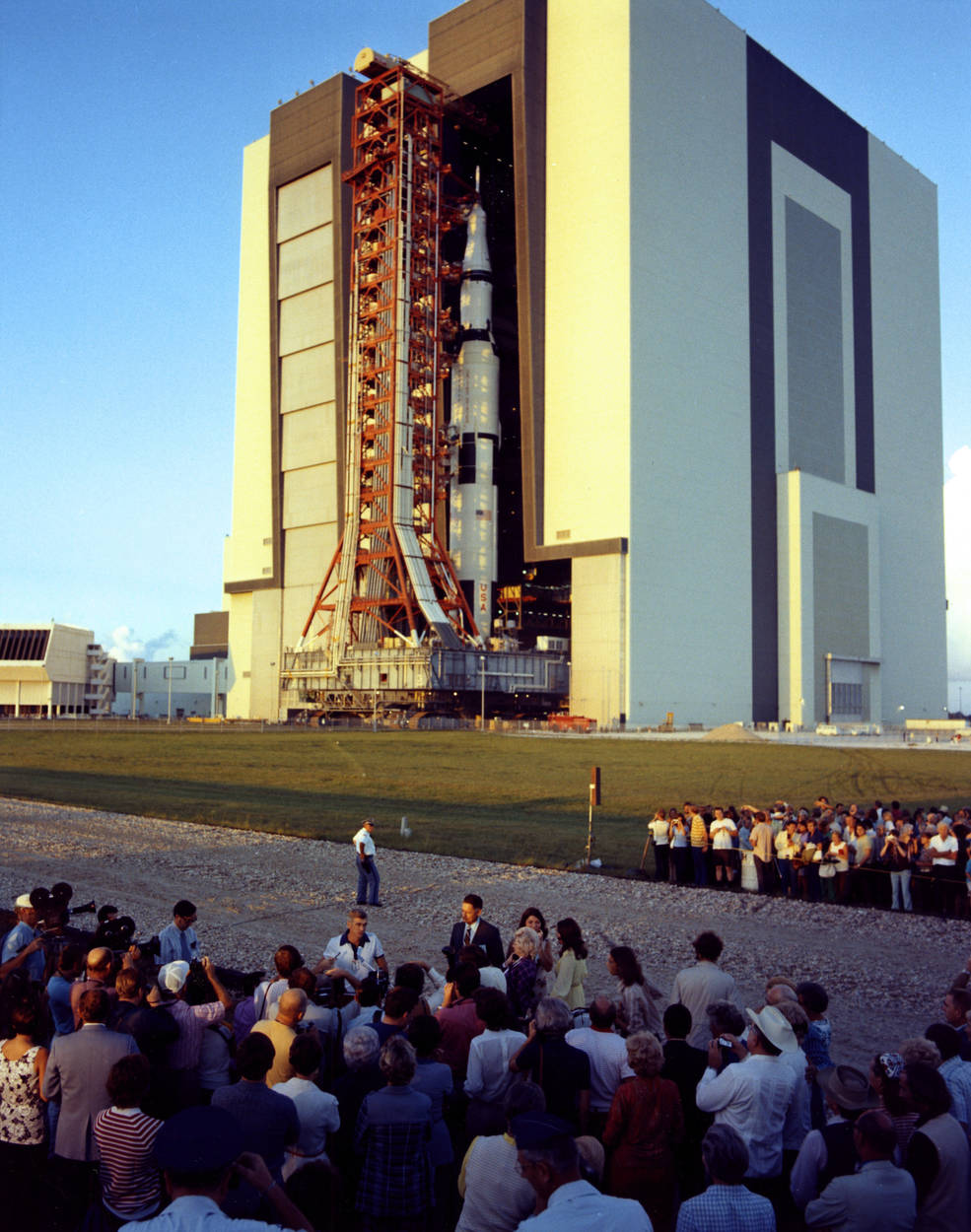
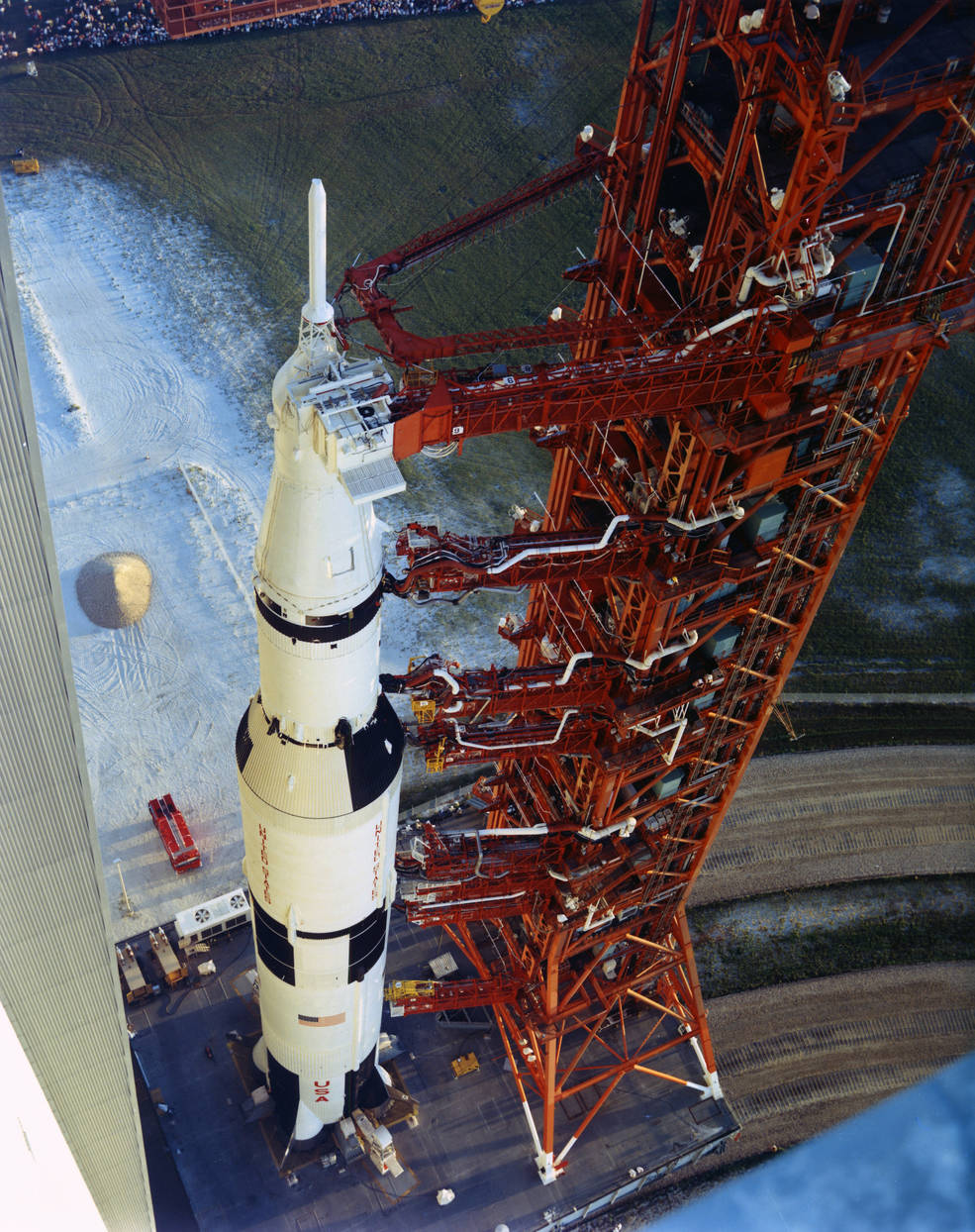
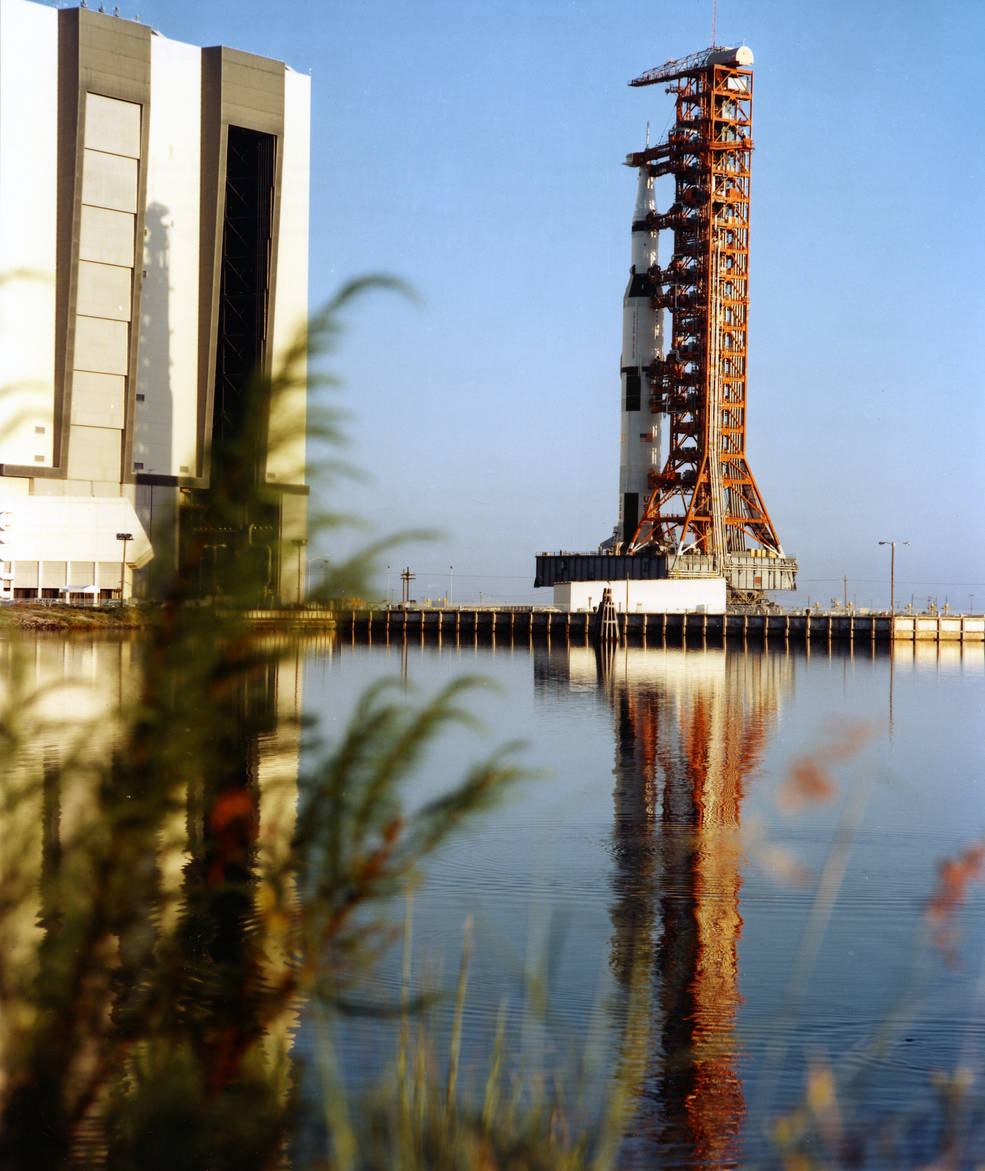
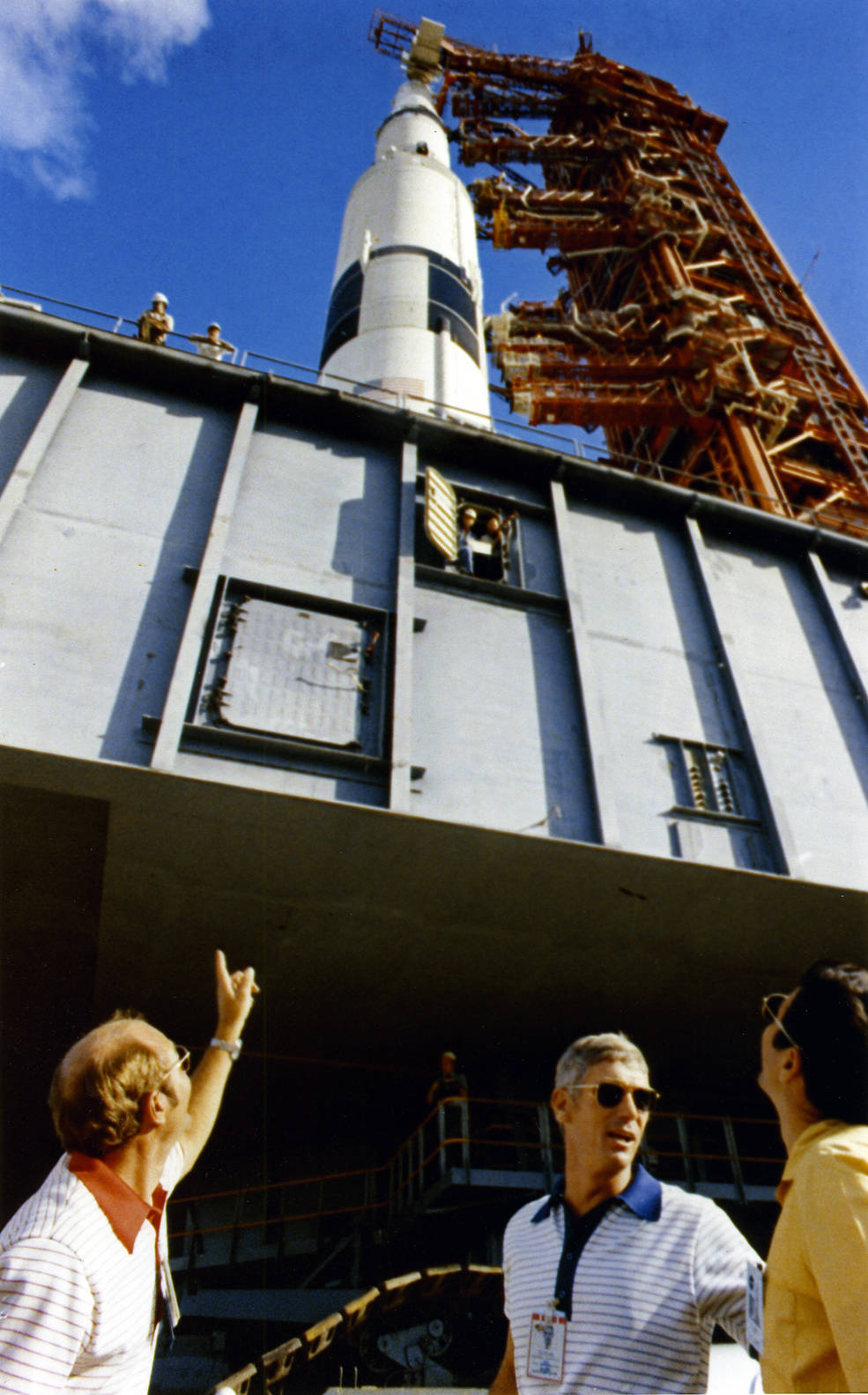
Left: The Apollo 17 Saturn V rocket exits the Vehicle Assembly Building (VAB) at NASA’s Kennedy Space Center in Florida, on its way to Launch Pad 39A. Middle left: The Apollo 17 Saturn V rollout as seen from the roof of the VAB. Middle right: The Apollo 17 Saturn V begins its slow journey to the launch pad. Right: Apollo 17 astronauts Ronald C. Evans, left, Eugene A. Cernan, and Harrison H. “Jack” Schmitt during the rollout of their Saturn V rocket to Launch Pad 39A.
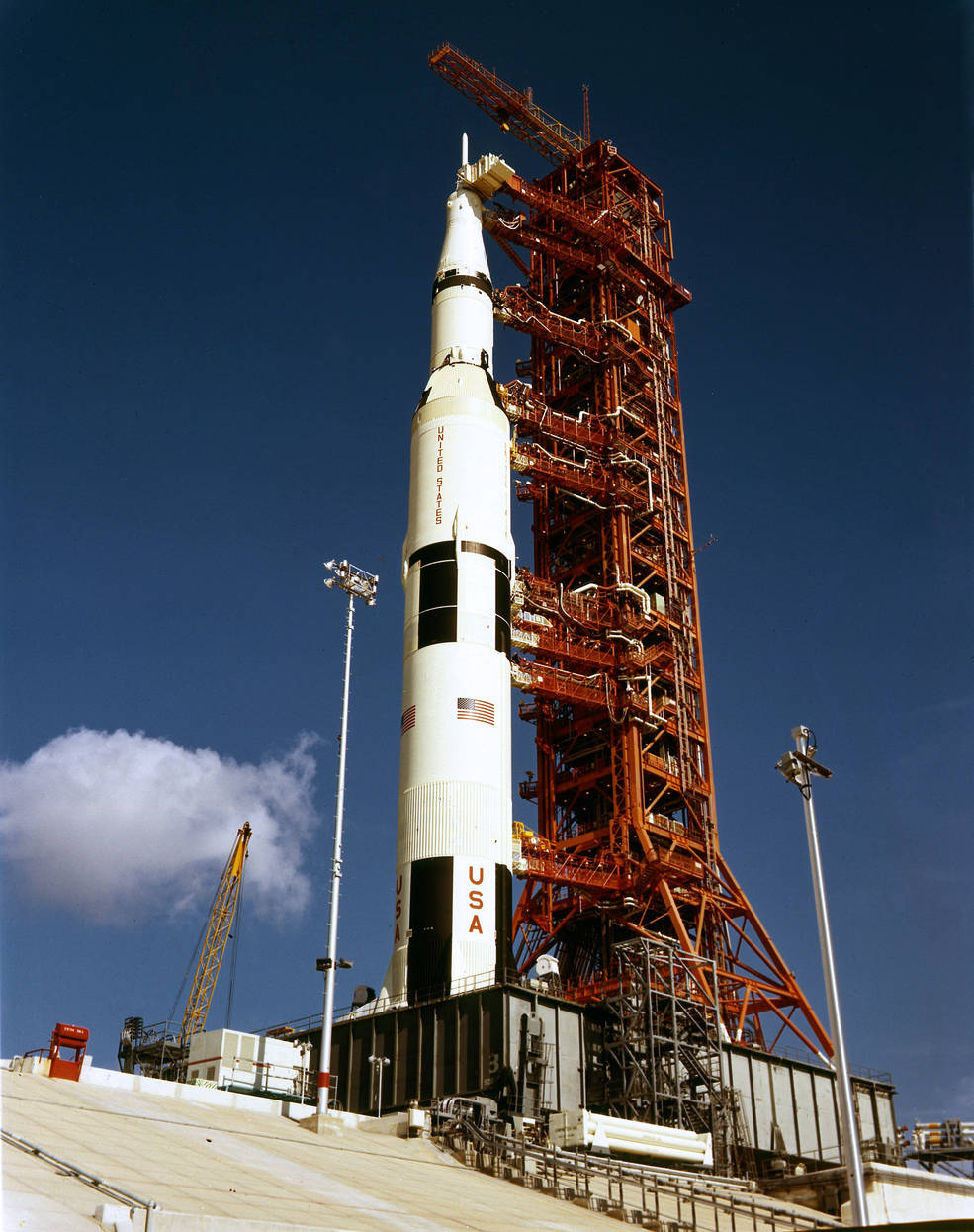
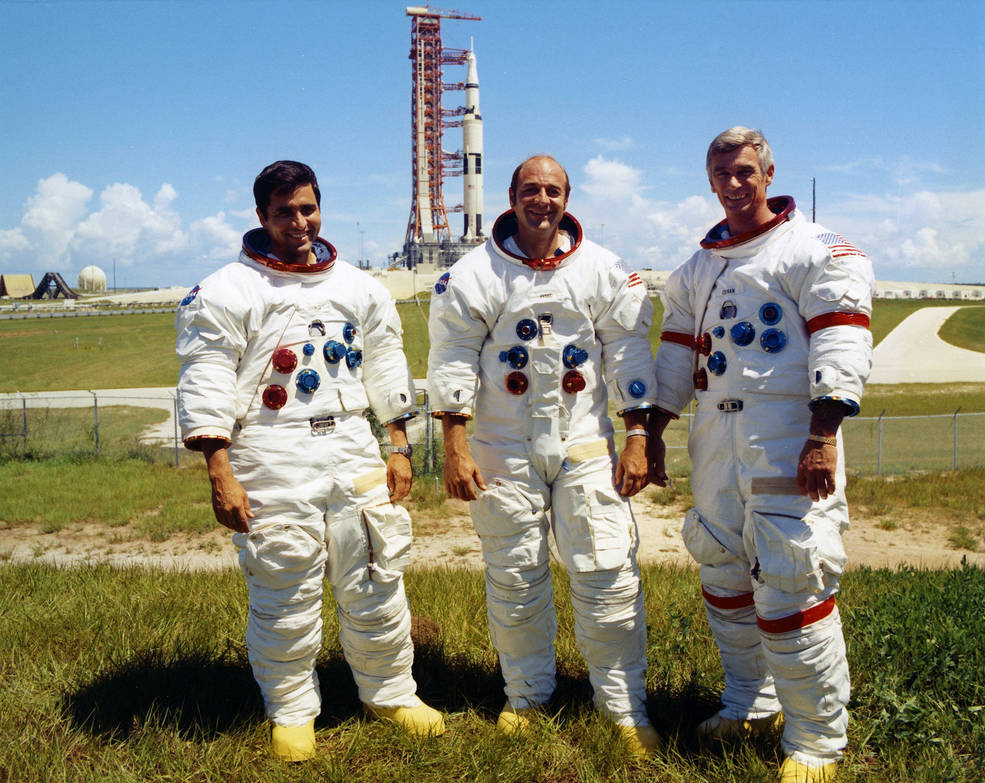
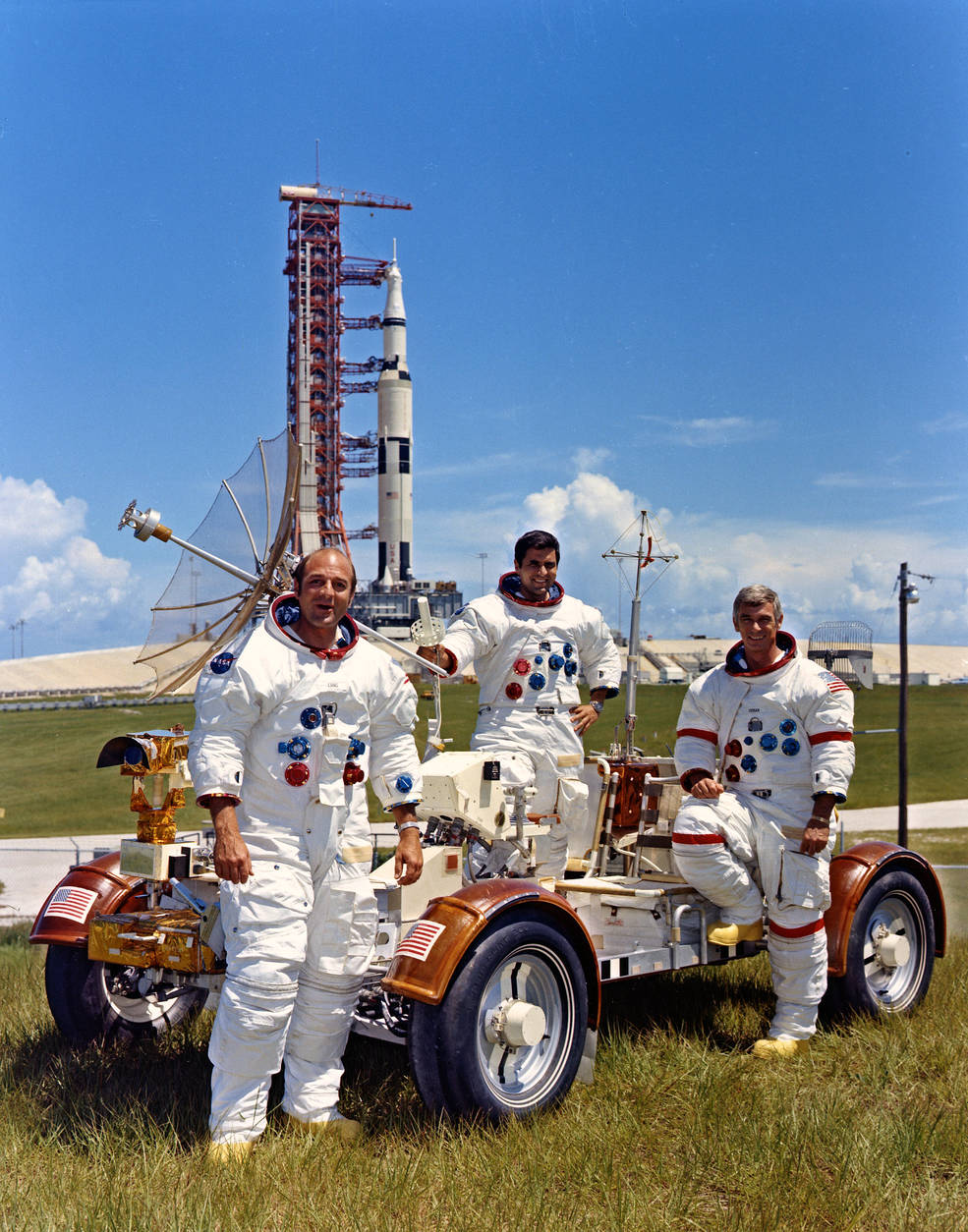
Left: The Apollo 17 Saturn V rocket following its arrival at Launch Pad 39A.
Middle: Apollo 17 astronauts Harrison H. “Jack” Schmitt, left, Ronald E. Evans,
and Eugene A. Cernan pose in front of their Saturn V rocket. Right: Evans,
left, Schmitt, and Cernan pose with the Lunar Roving Vehicle
at Launch Pad 39A.
On Aug. 28, with more than 5,000 guests and family members of KSC employees watching, workers rolled the Apollo17 Saturn V from the VAB to Launch Pad 39A. Cernan, Evans, and Schmitt visited the viewing site near the VAB to greet guests as the space vehicle exited the VAB. Wearing their spacesuits, they later posed for photographers, using the Saturn V rocket on the pad as a backdrop.
Preparations for Skylab
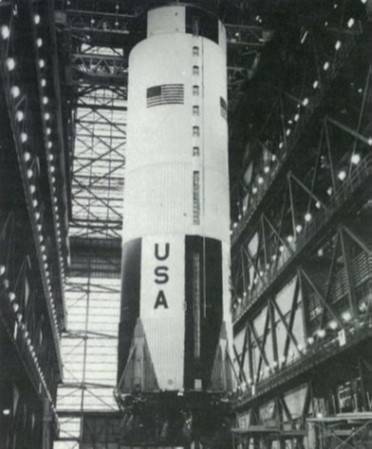
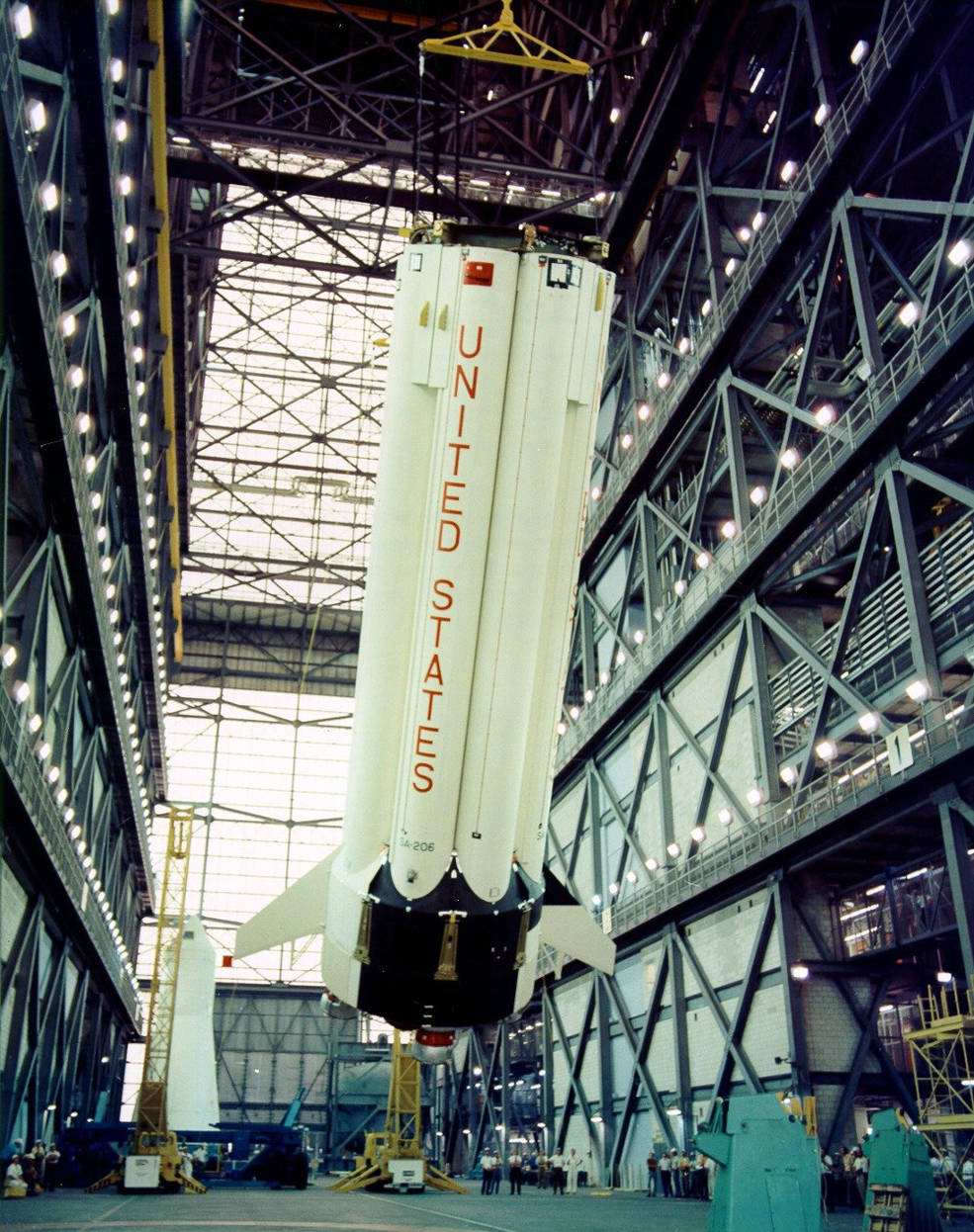
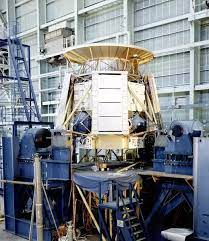
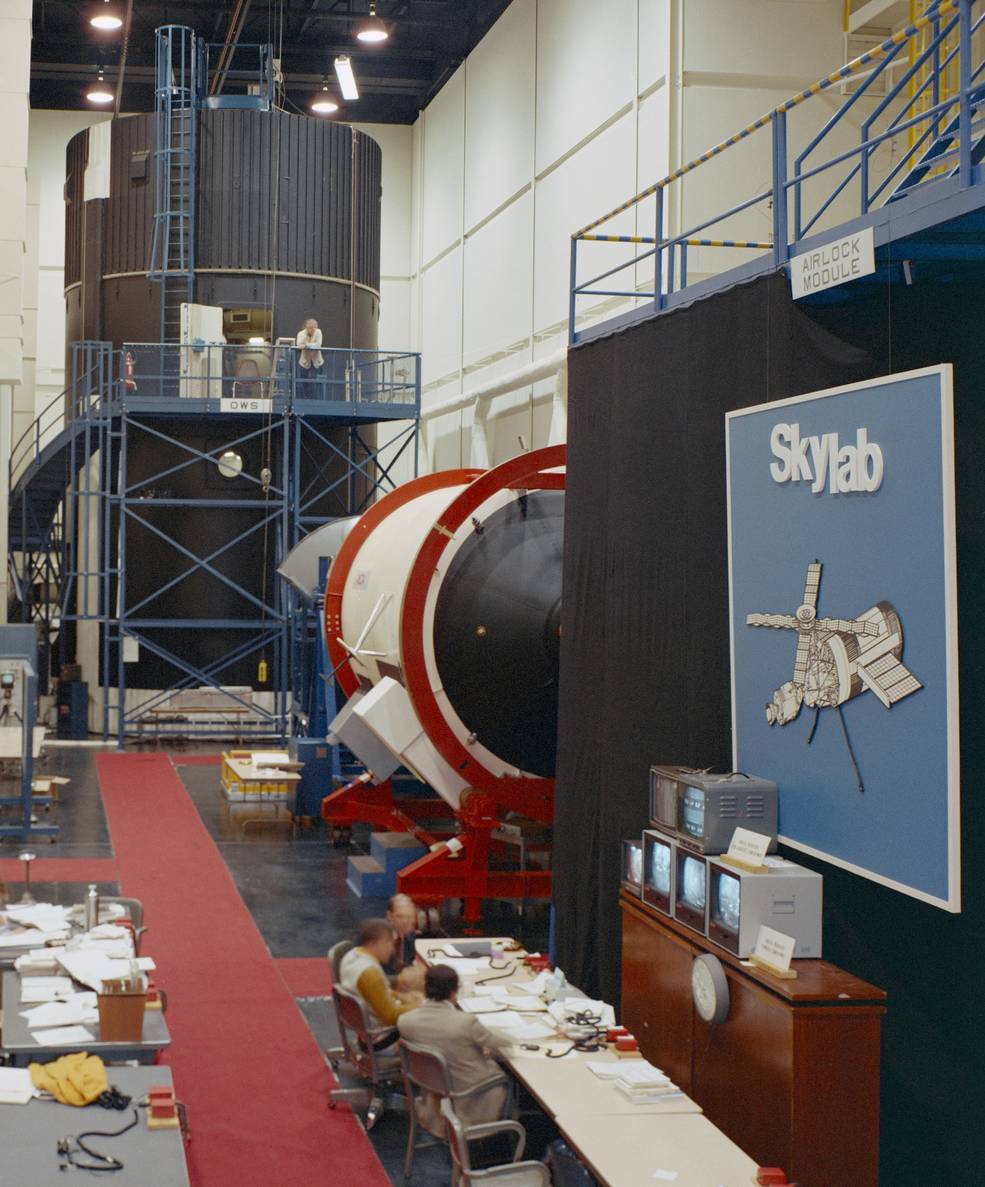
Left: In the Vehicle Assembly Building (VAB) at NASA’s Kennedy Space Center, workers lift the first stage of the Saturn V rocket for the Skylab 1 space station to begin its assembly on a Mobile Launcher. Middle left: Workers in the VAB lift the first stage of the Saturn IB rocket for the Skylab 2 crew to the space station. Middle right: In the Vibration and Acoustic Test Facility at the Manned Spacecraft Center (MSC), now NASA’s Johnson Space Center in Houston, workers prepare the Skylab space station’s Apollo Telescope Mount for a series of vibration tests. Right: Training modules of the Skylab space station at MSC’s Mission Simulation and Training Facility.
Workers in the VAB remained very busy through August and September 1972. Having just assembled and rolled out the Saturn V rocket for Apollo 17, they turned their attention to the assembly of two launch vehicles for the upcoming Skylab program. After its arrival at KSC on July 26, 1972, on Aug. 2 workers placed the first stage of the Saturn V for the Skylab 1 space station onto ML-2 in the VAB’s High Bay 2. In High Bay 1, workers placed the first stage of the Saturn IB rocket for Skylab 2, the first crewed mission to the station, on ML-1 on August 31. They placed that stage on a pedestal on ML-1 known as the milkstool that allowed the smaller Saturn IB rocket to use the same facilities as the larger Saturn V. Workers completed the assembly of the two rockets in September. This marked the first time since 1969 that workers at KSC processed three Saturn vehicles at the same time. The CSM for the Skylab-2 crew mission had arrived in the MSOB on July 19 to begin processing for flight.
Workers around the country processed components of the Skylab space station to prepare it for launch, then planned for April 30, 1973. In MSC’s Vibration and Acoustics Test Facility, on July 17 engineers completed an 18-month test program of the Skylab payload shroud, the Apollo Telescope Mount (ATM), and the Multiple Docking Adapter. The ATM also completed vacuum tests in Chamber A of MSC’s Space Environment Simulation Laboratory during June and July. At the McDonnell Douglas Corporation in Huntington Beach, California, engineers completed a three-day test of the Skylab Orbital Workshop in early June, following which they shipped it to NASA’s Marshall Space Flight Center (MSFC) in Huntsville, Alabama, for further testing. The major Skylab components began to arrive at KSC in September to begin final processing for flight.
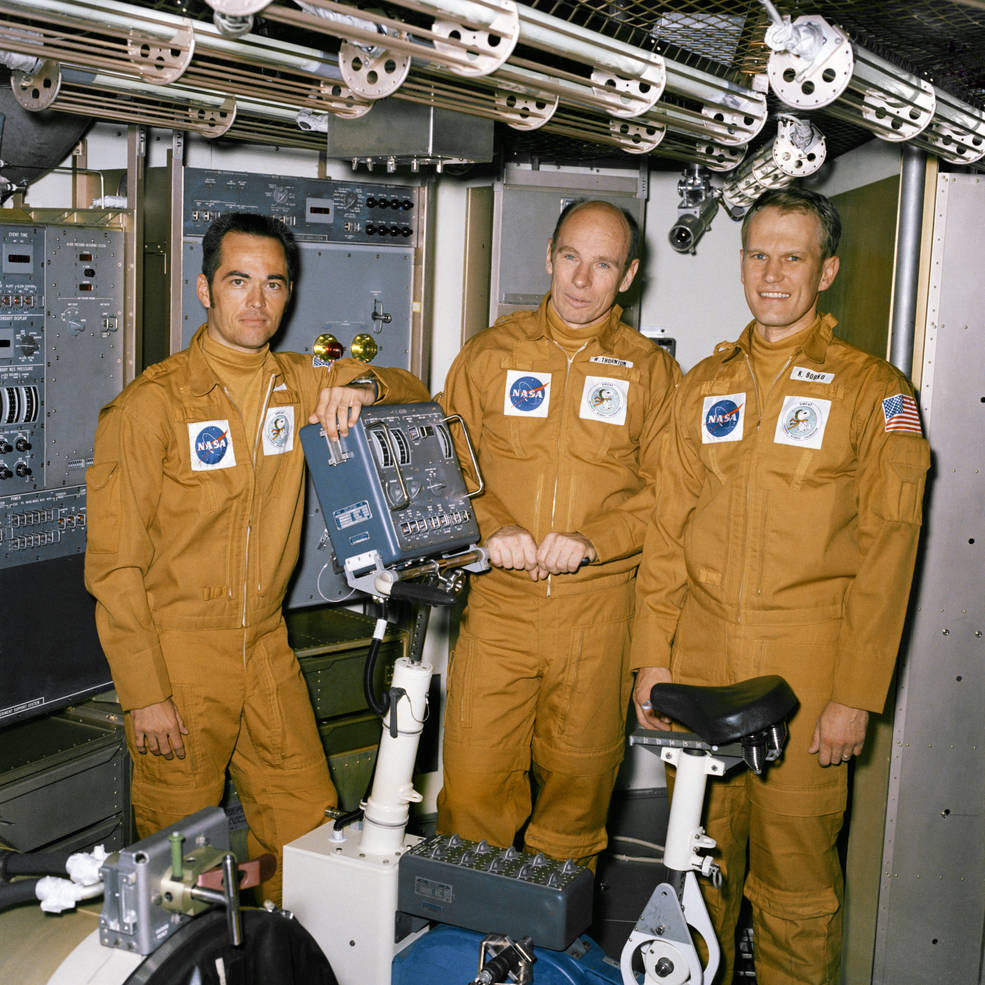
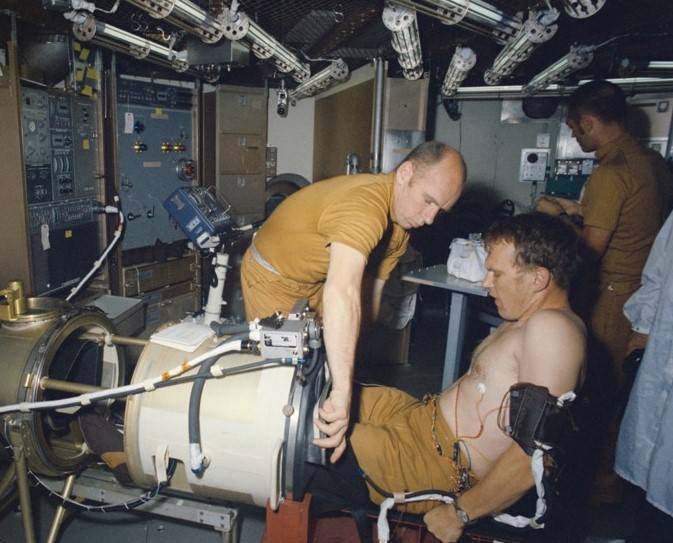
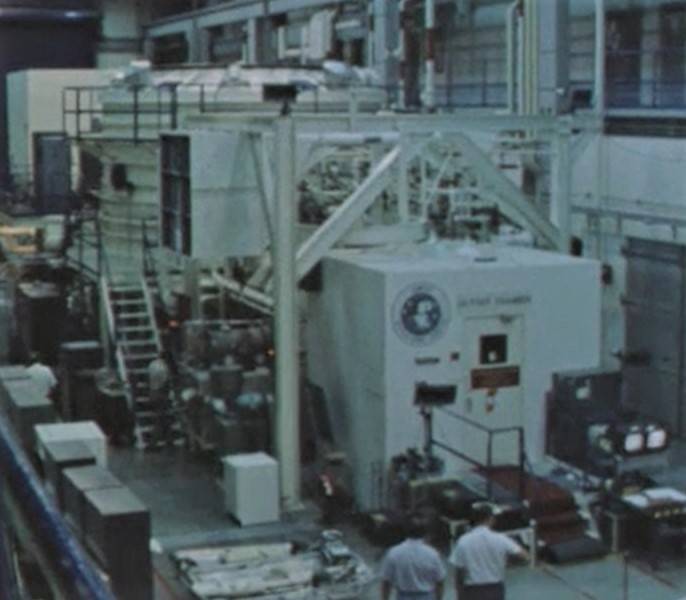
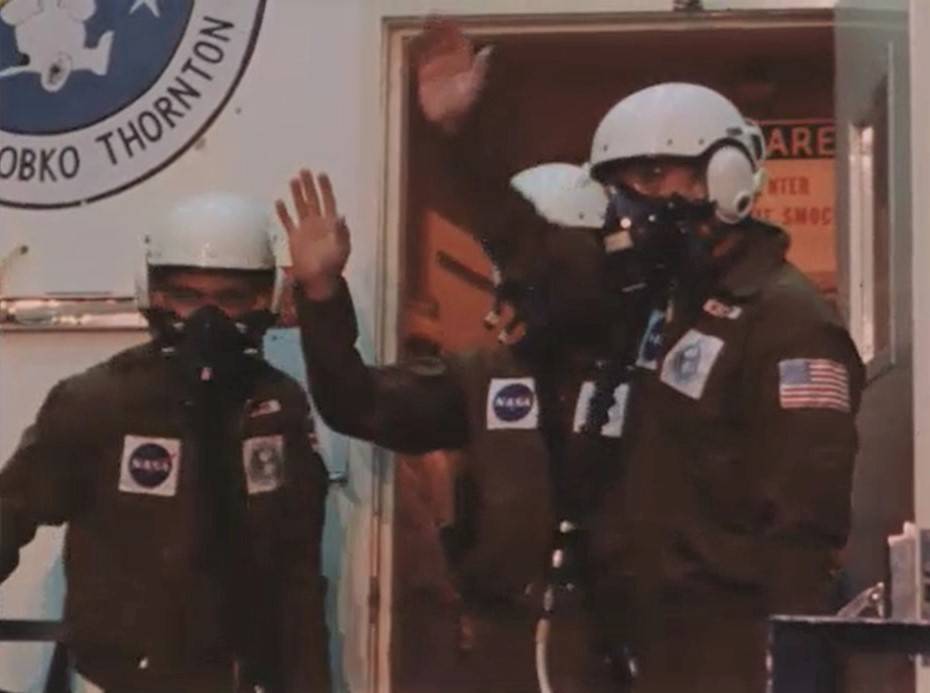
Left: Astronauts Robert L. Crippen, left, William E. Thornton, and Karol J. “Bo” Bobko, the crew for the Skylab Medical Experiment Altitude Test (SMEAT). Middle left: Thornton, left, Bobko, and Crippen during training for SMEAT. Middle right: The 20-foot altitude chamber at the Manned Spacecraft Center, now NASA’s Johnson Space Center in Houston, where SMEAT took place. Right: Crippen, left, Bobko, and Thornton, wearing oxygen masks, prepare to enter the chamber to begin SMEAT.
The nine astronauts assigned to the Skylab program and their backups continued training for the long-duration missions at MSC and MSFC. To gain experience with long-duration operations and especially the biomedical experiments to be conducted by the crews, NASA established the Skylab Medical Experiment Altitude Test (SMEAT). The ground-based test in the 20-foot altitude chamber at MSC consisted of a 56-day simulation of a Skylab mission. Astronauts Robert L. Crippen, Dr. William E. Thornton, and Karol J. “Bo” Bobko began the SMEAT simulation on July 26, 1972. Because the test was conducted at an operating pressure of five pounds per square inch, the environment planned for Skylab, the astronauts entered the altitude chamber wearing oxygen masks. This oxygen pre-breathe exercise prevented decompression sickness, also known as the bends. Crippen, Thornton, and Bobko successfully completed the test on Sep. 19. Many critical lessons were learned from SMEAT that improved the research and operations carried out aboard America’s first space station.
To be continued…
World events in June 1972:
June 1 – Pablo Picasso completes his final work, “The Embrace.”
June 5 – United Nations Conference on the Human Environment opens in Stockholm.
June 6 – David Bowie releases his album “The Rise & Fall of Ziggy Stardust and the Spiders from Mars.”
June 9 – Bruce Springsteen signs a 10-record deal with Columbia Records.
June 17 – Five men arrested for trying to bug Democratic National Headquarters at the Watergate Hotel in Washington, D.C.
June 23 – Hurricane Agnes becomes the costliest U.S. natural disaster to that time, affecting 15 states and causing $3 billion in damages.
June 23 – President Richard M. Nixon signs act barring sex discrimination in college sports.
June 27 – Video game and home computer company Atari, Inc. is founded by Nolan Bushnell and Ted Dabney in Sunnyvale, California.

























